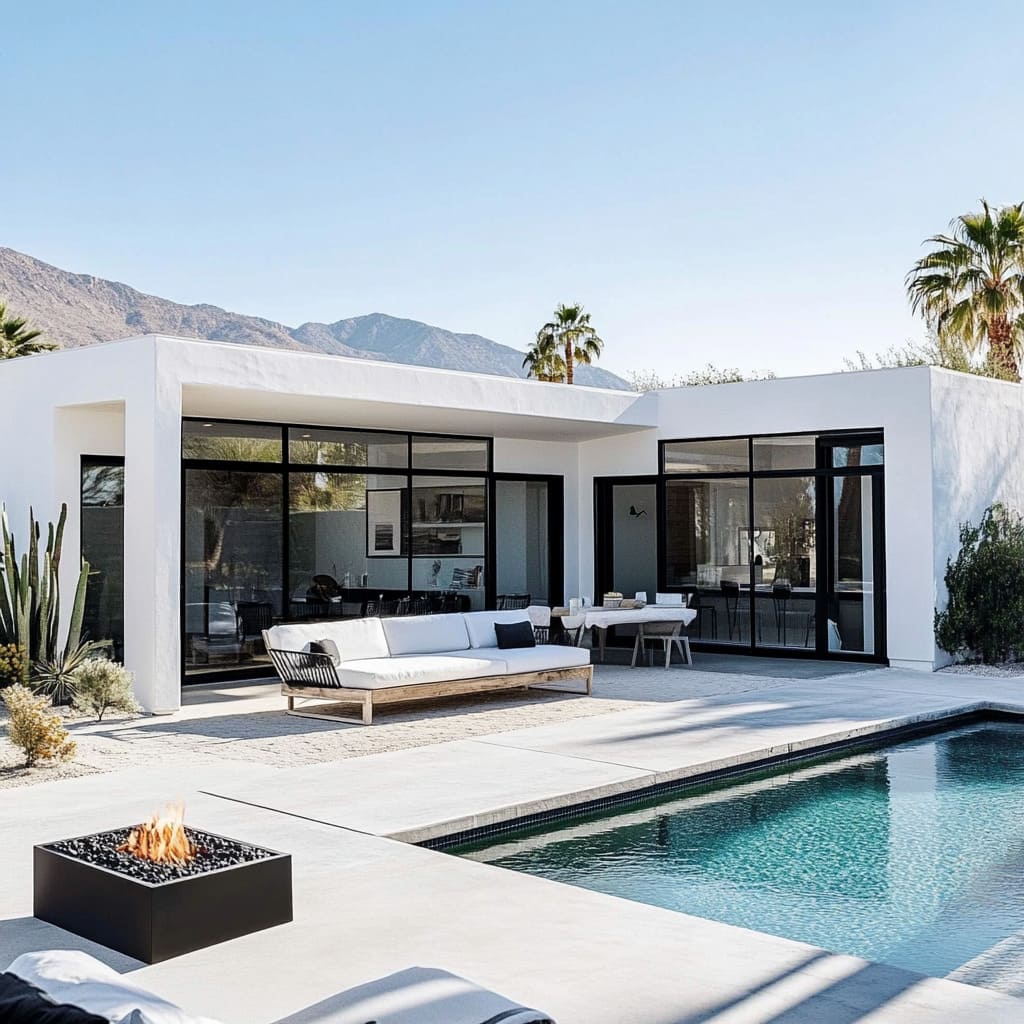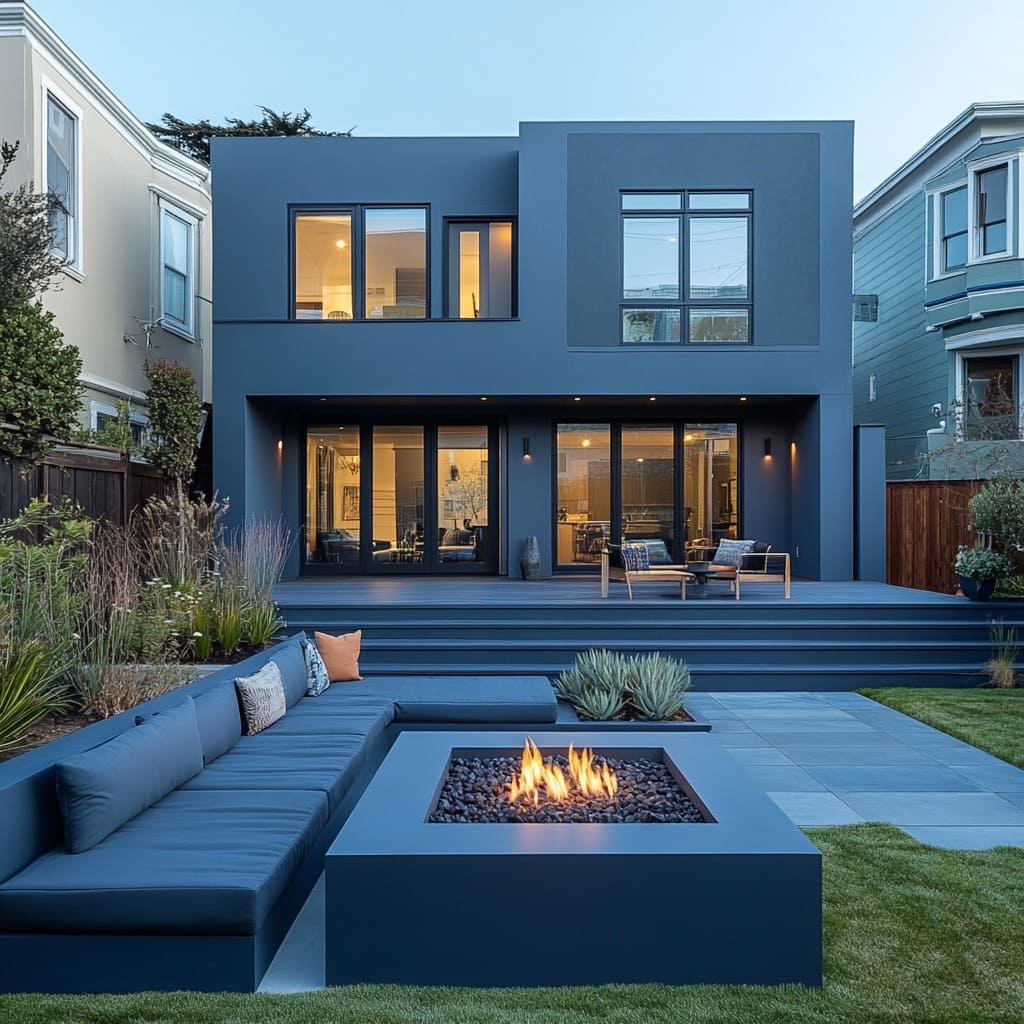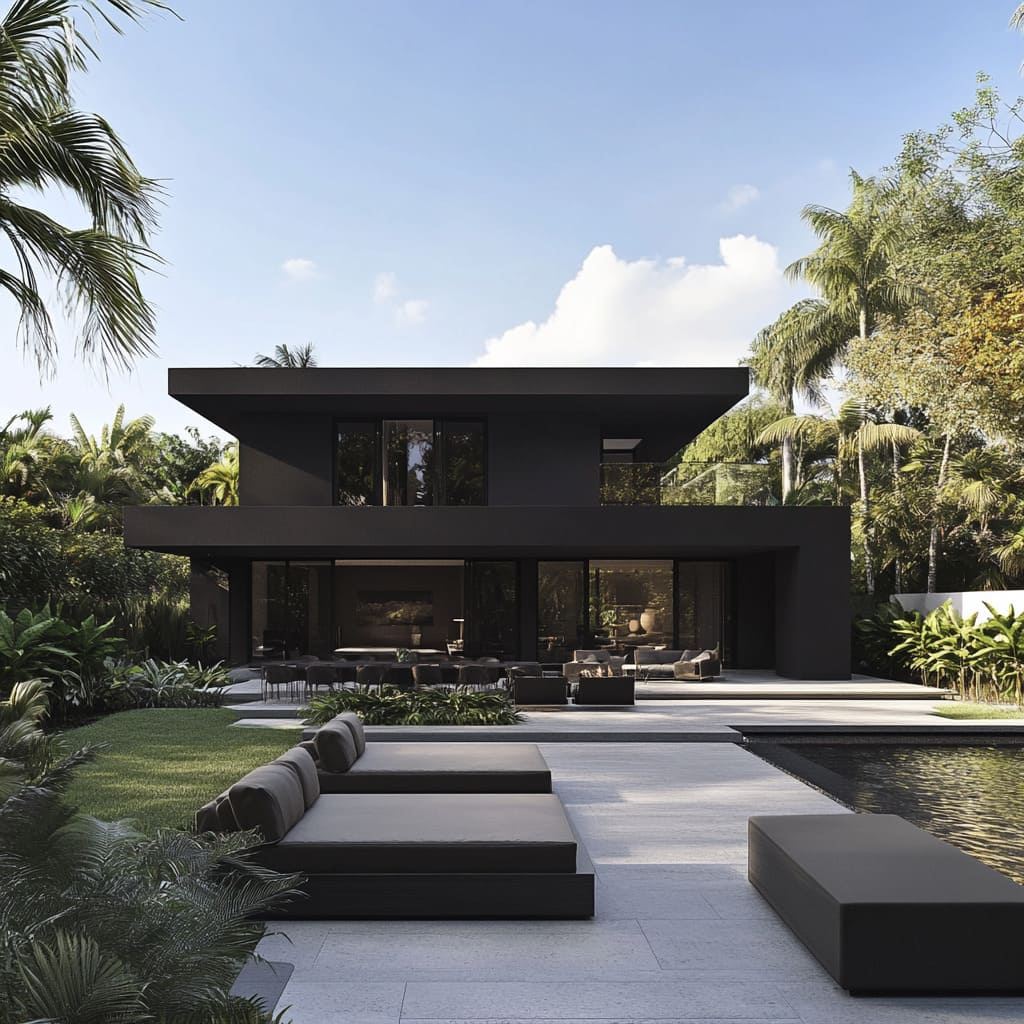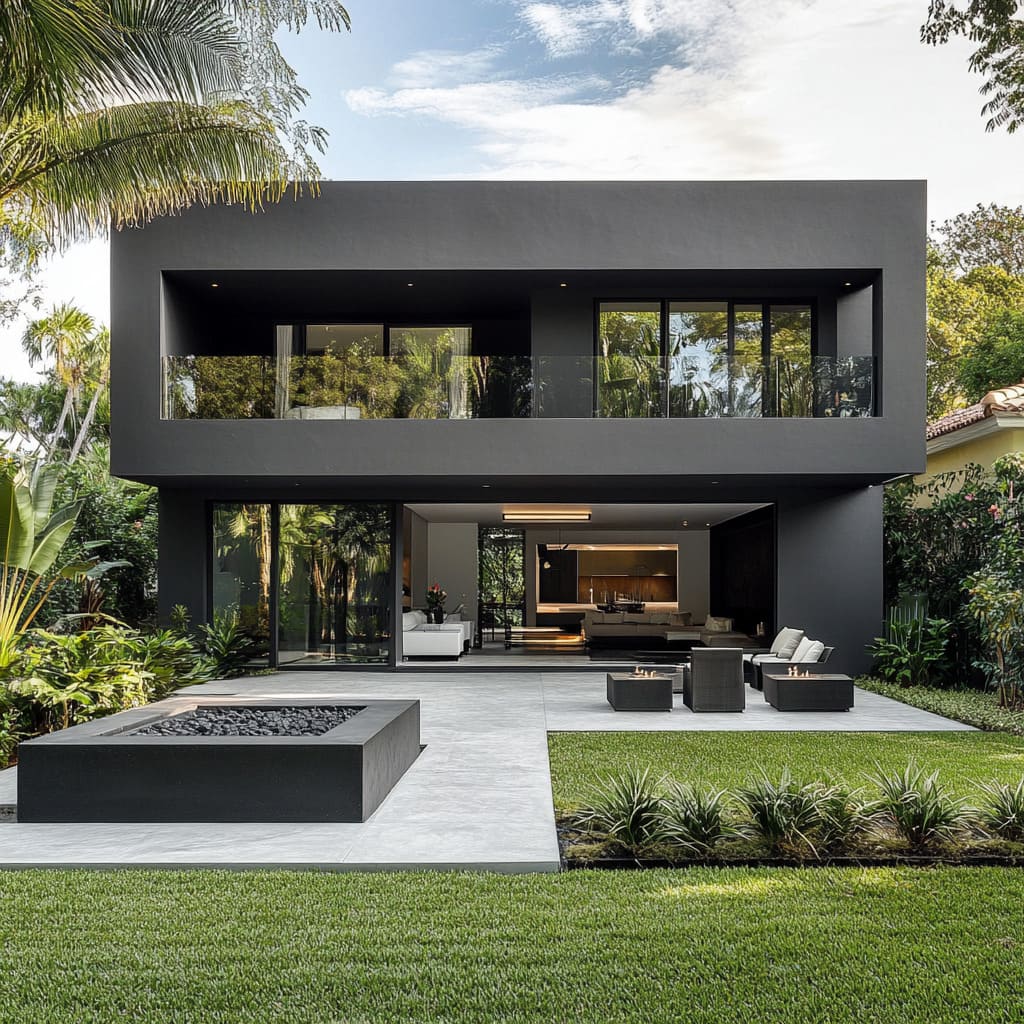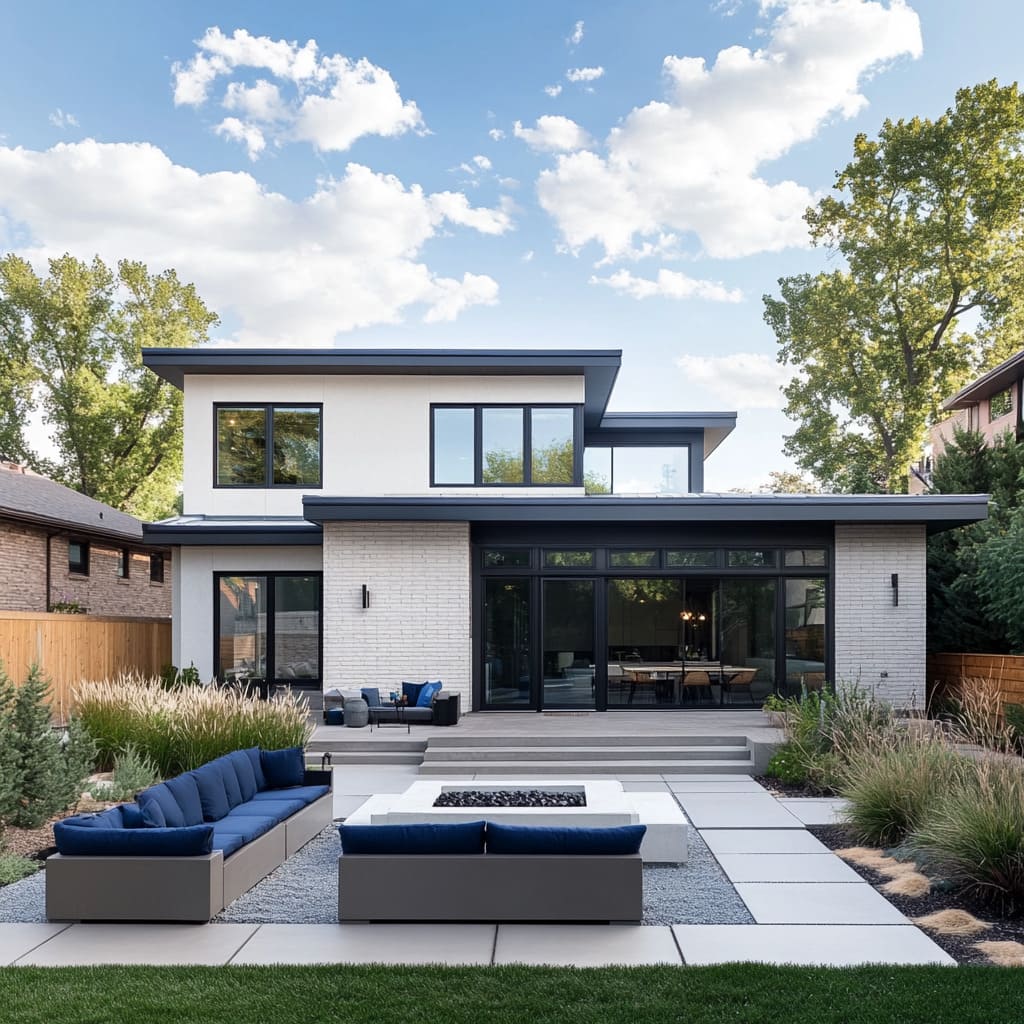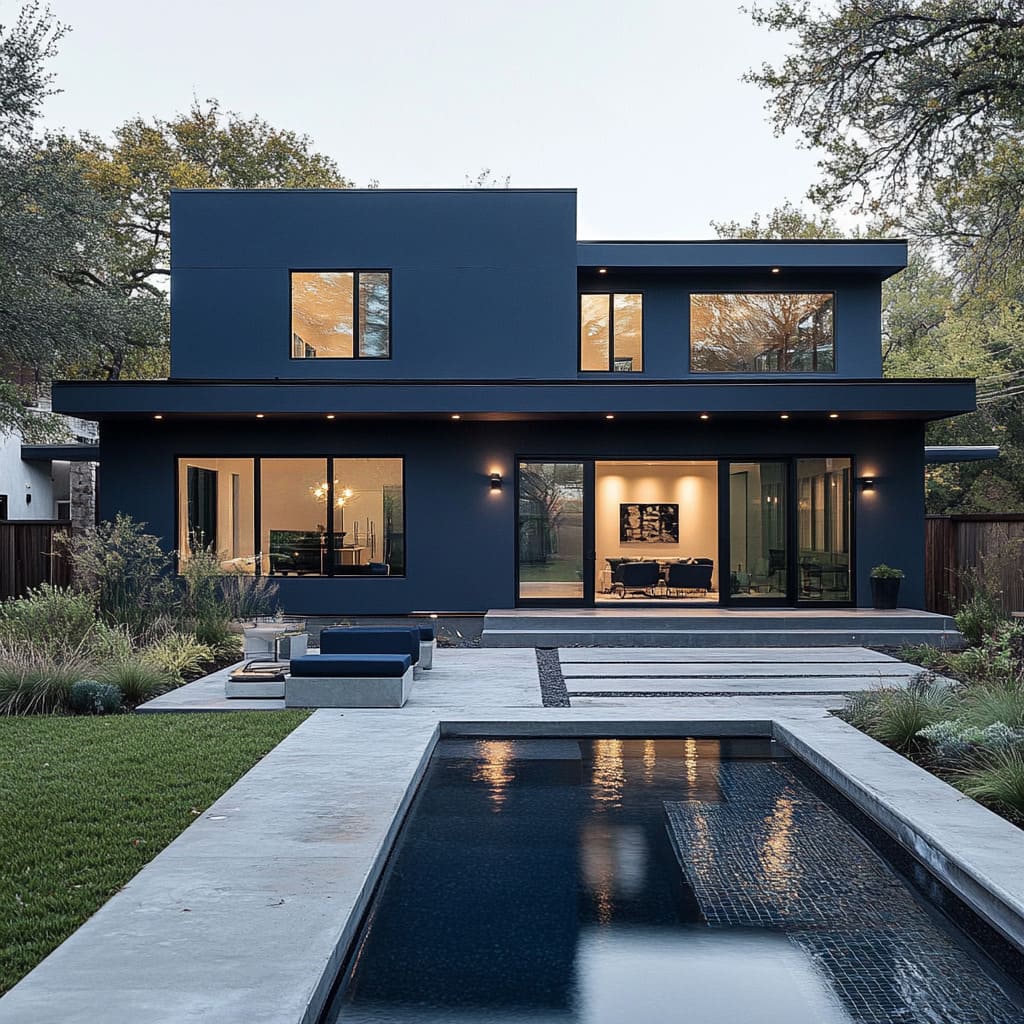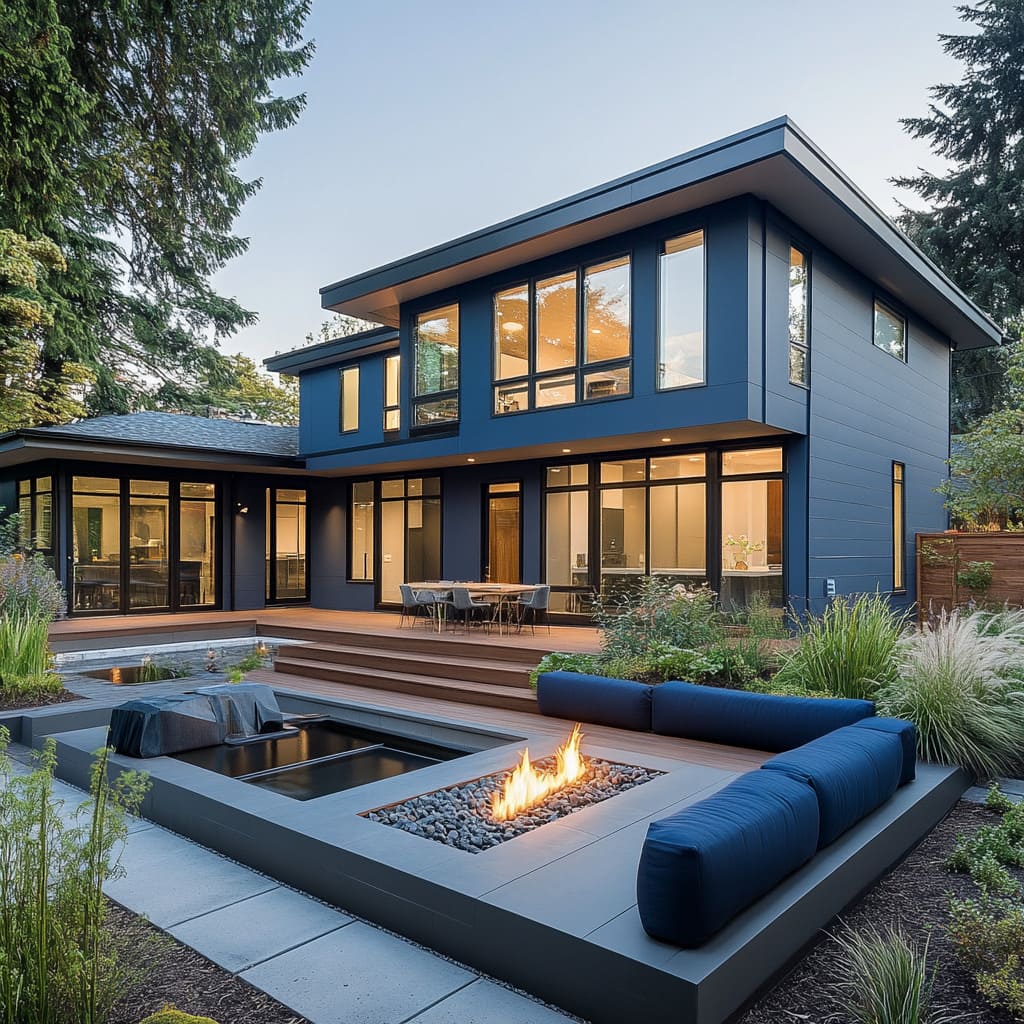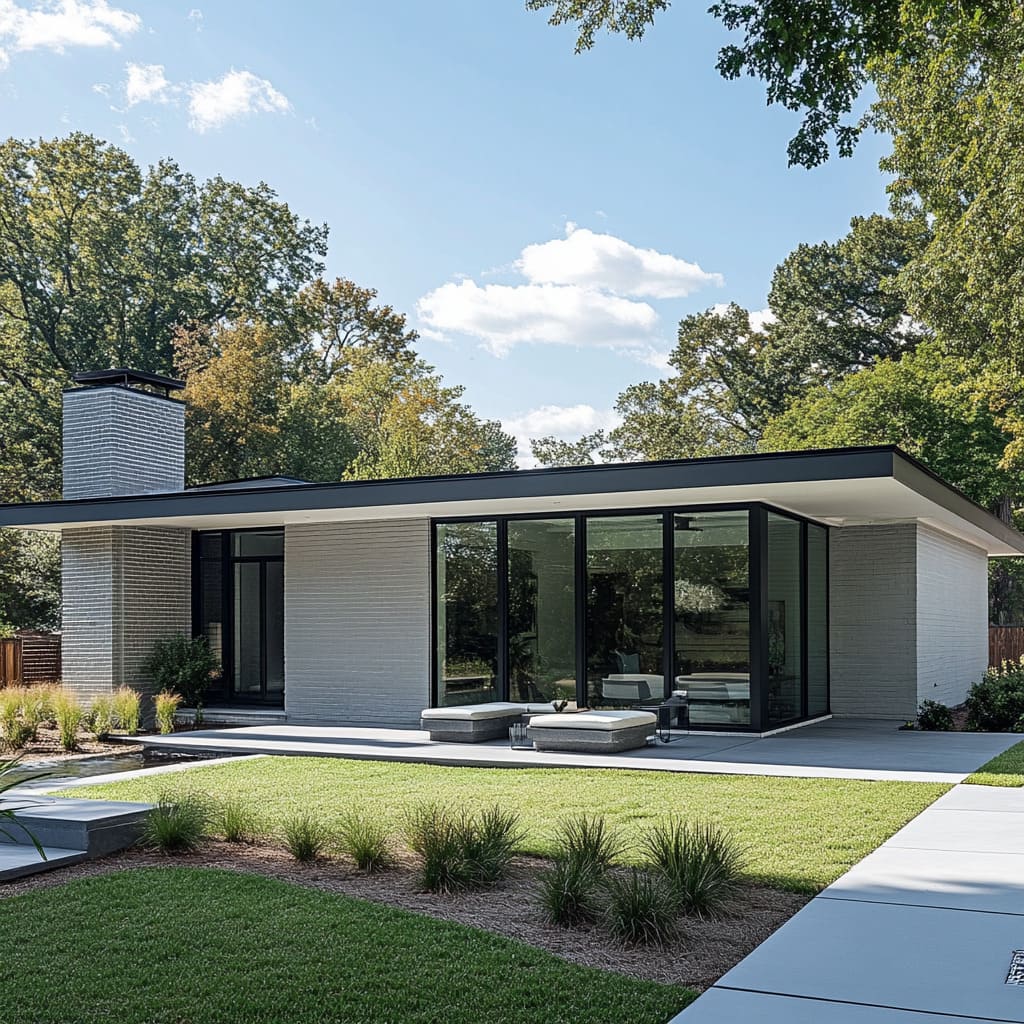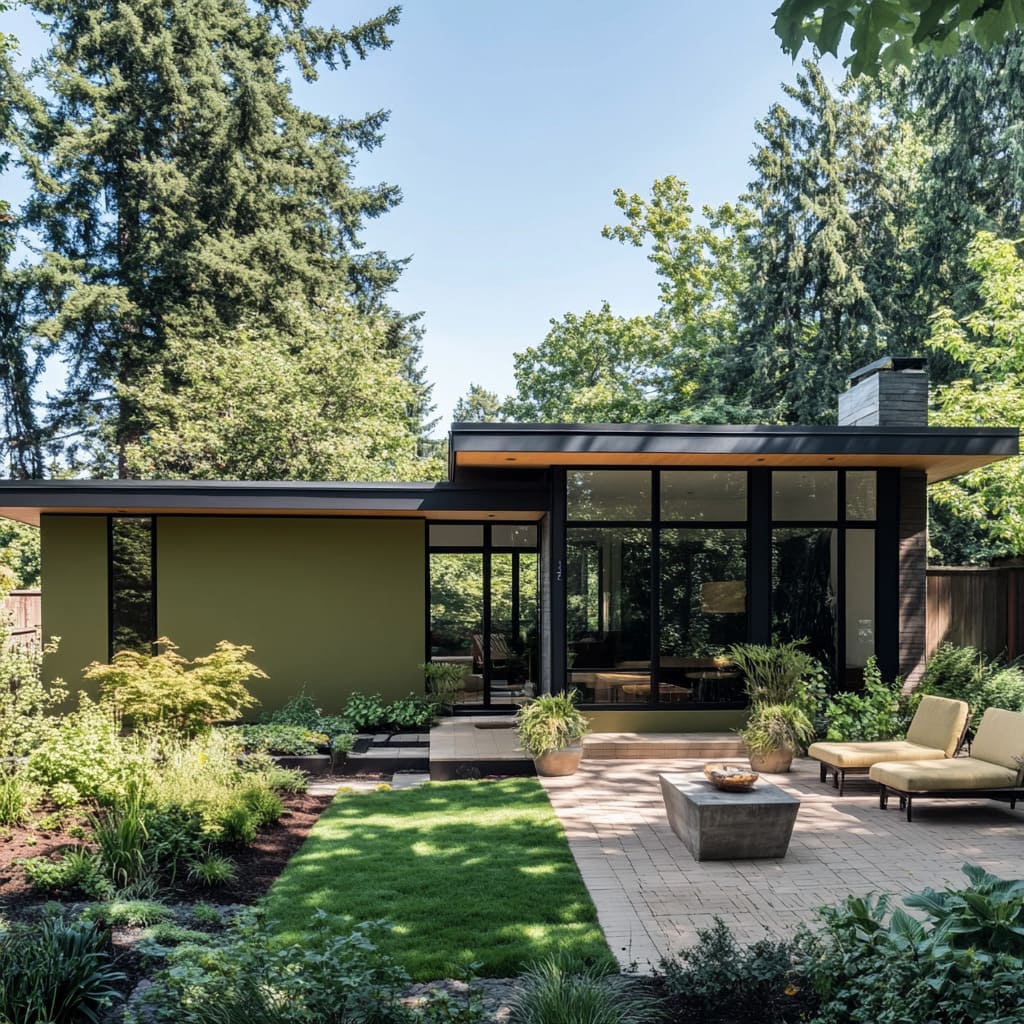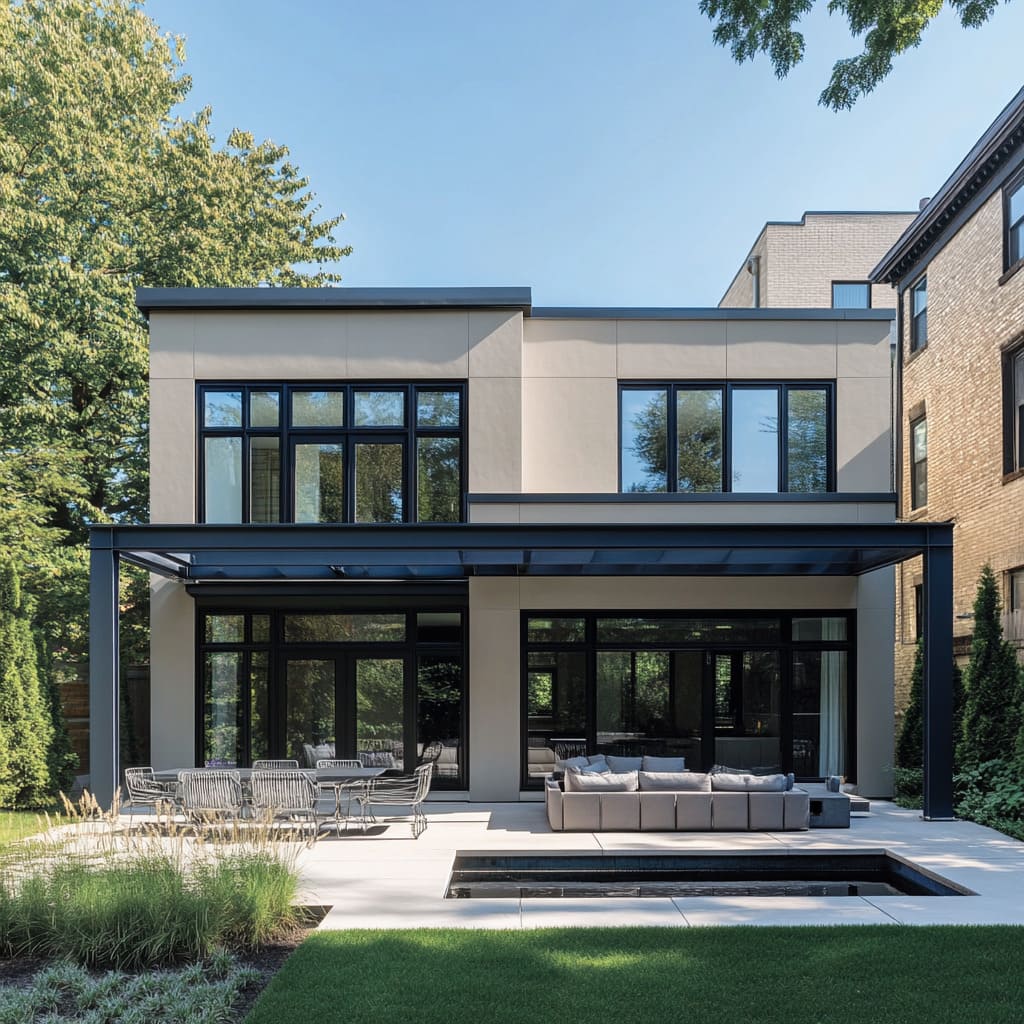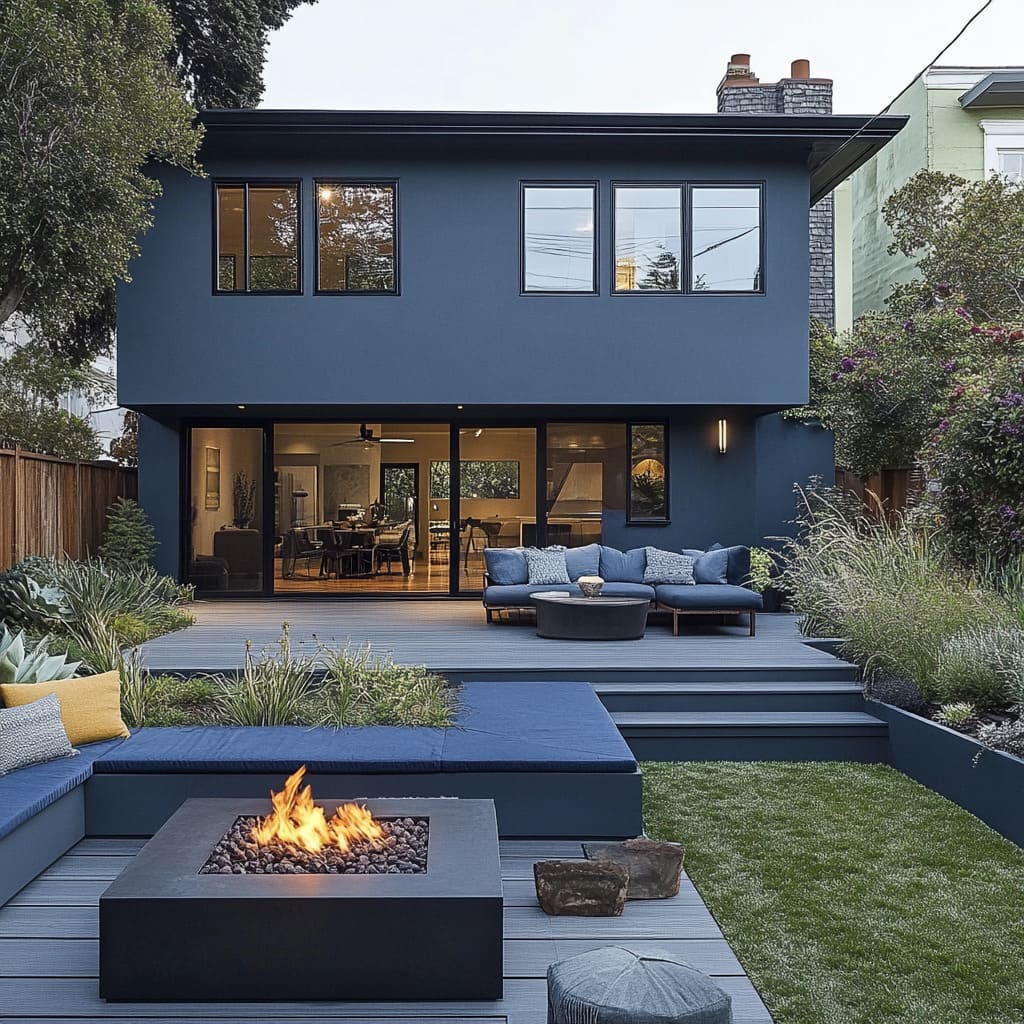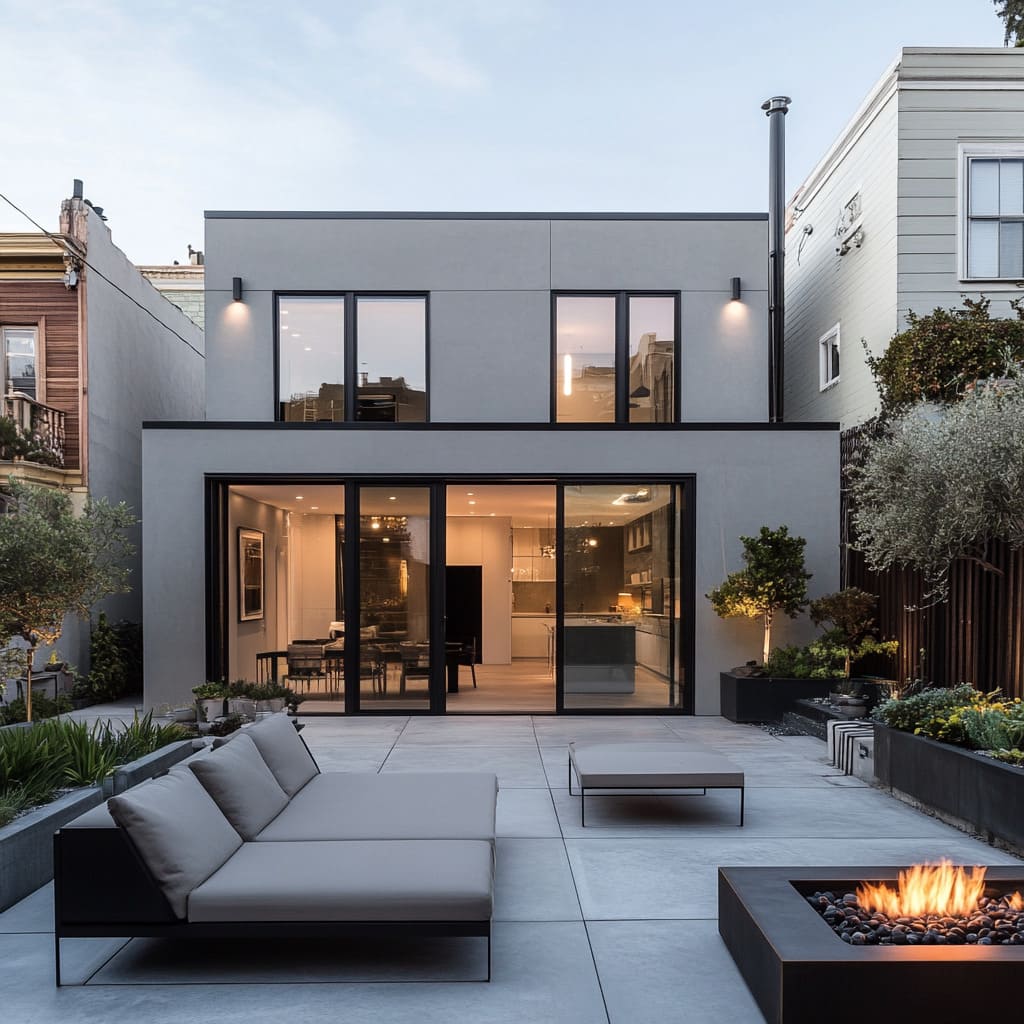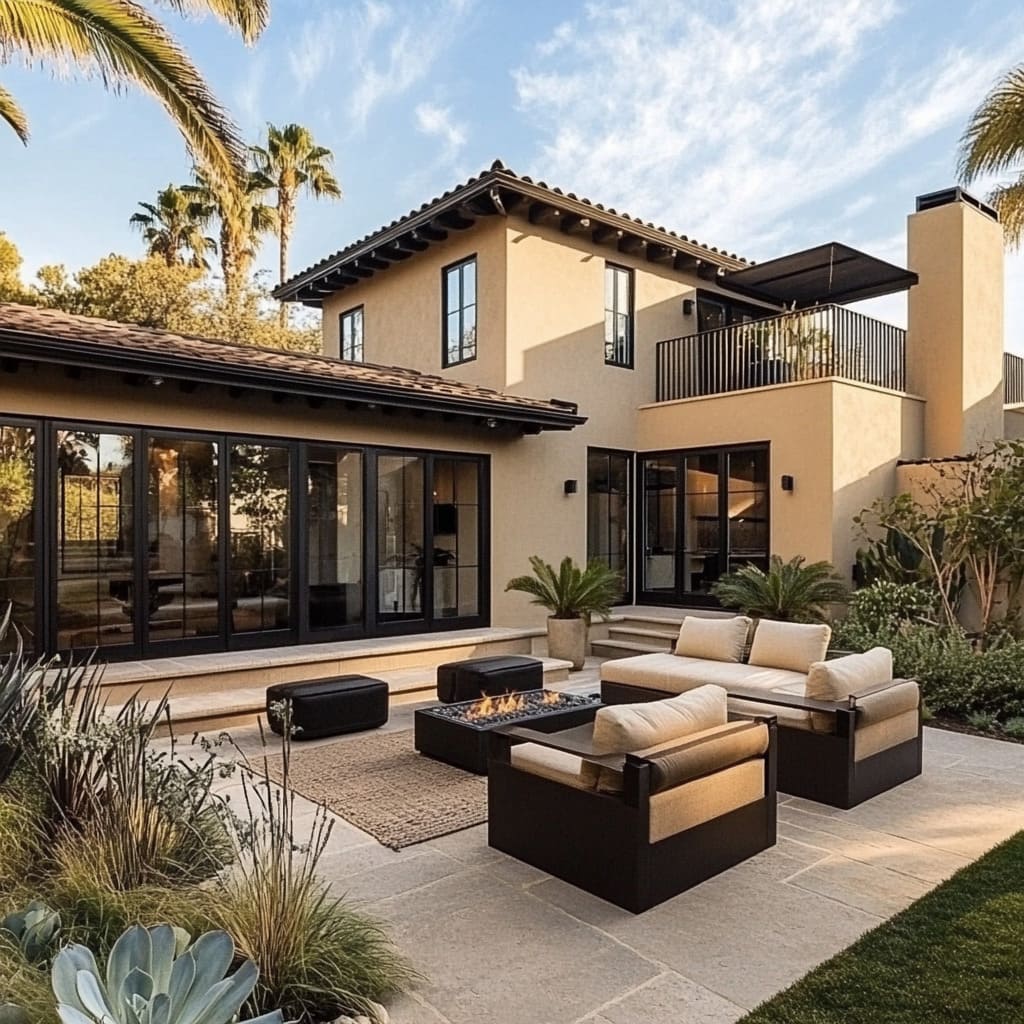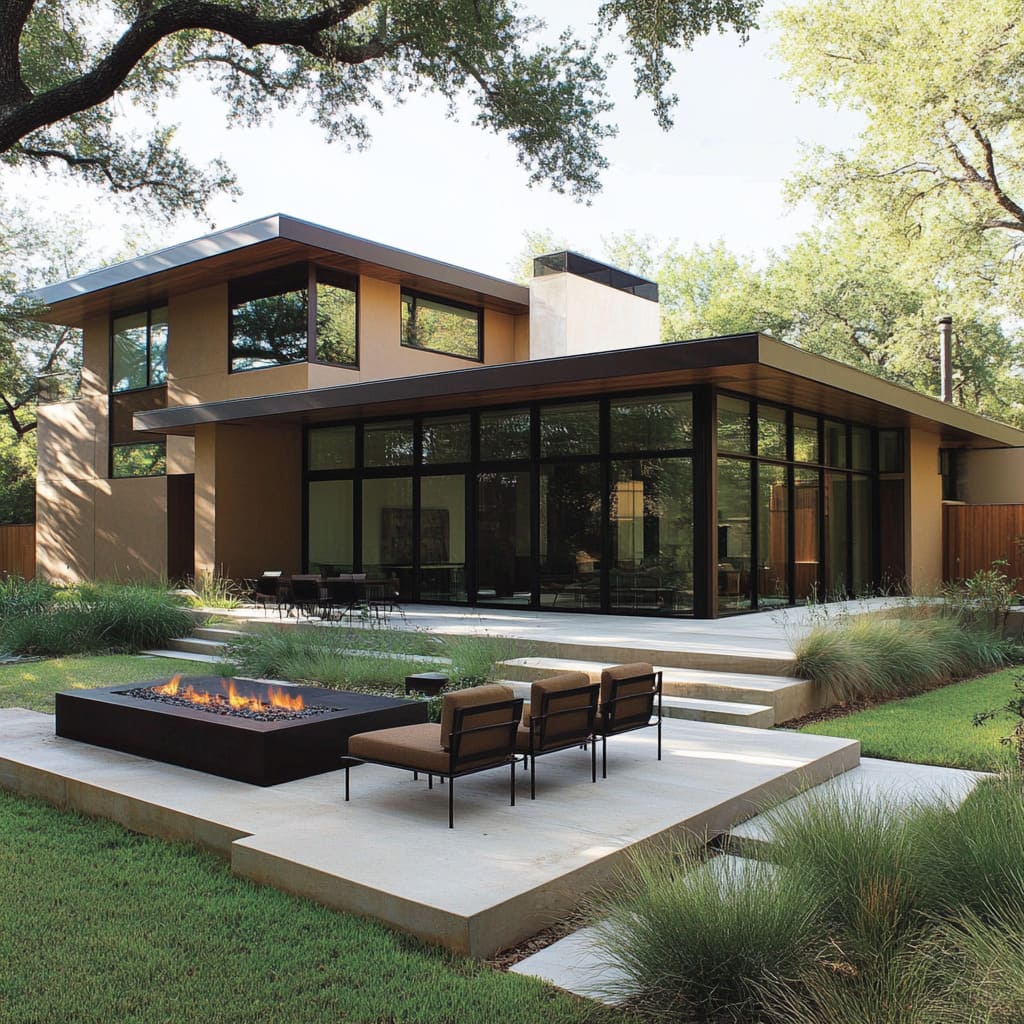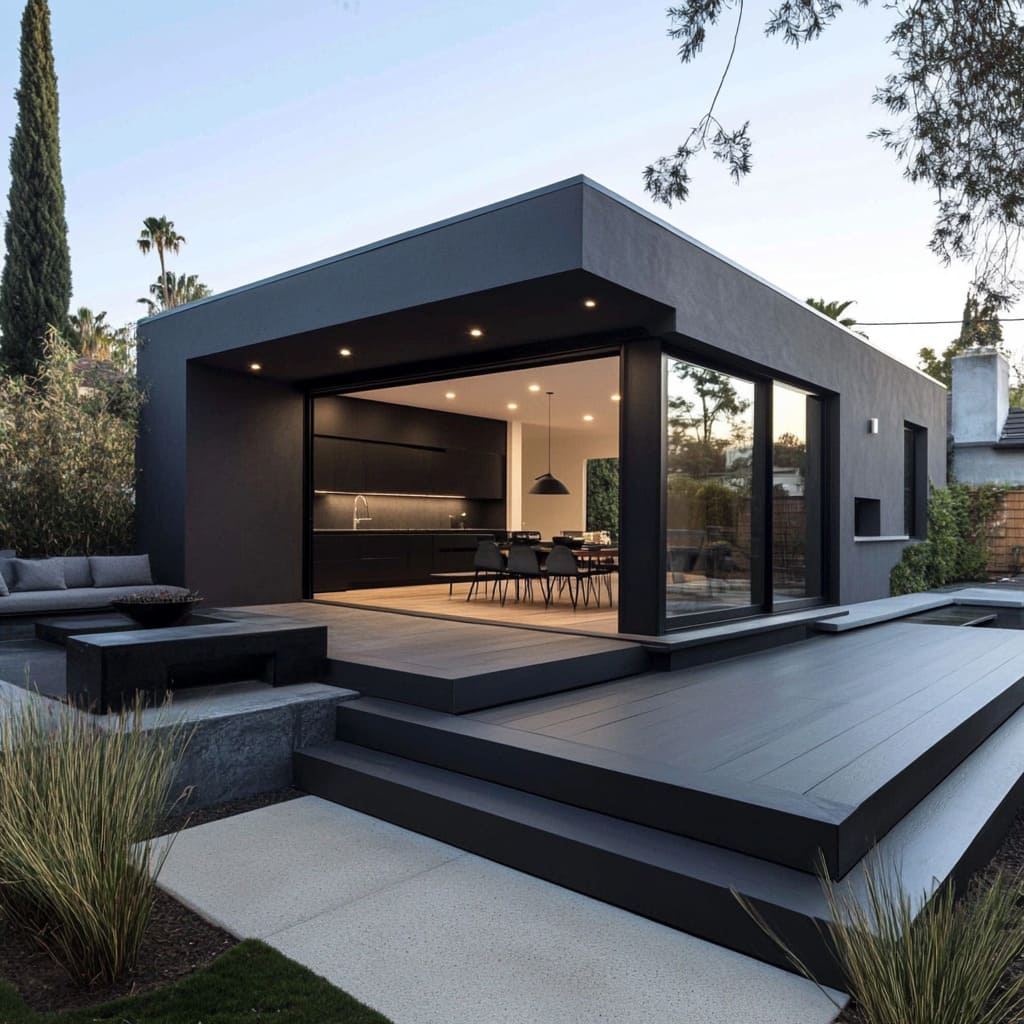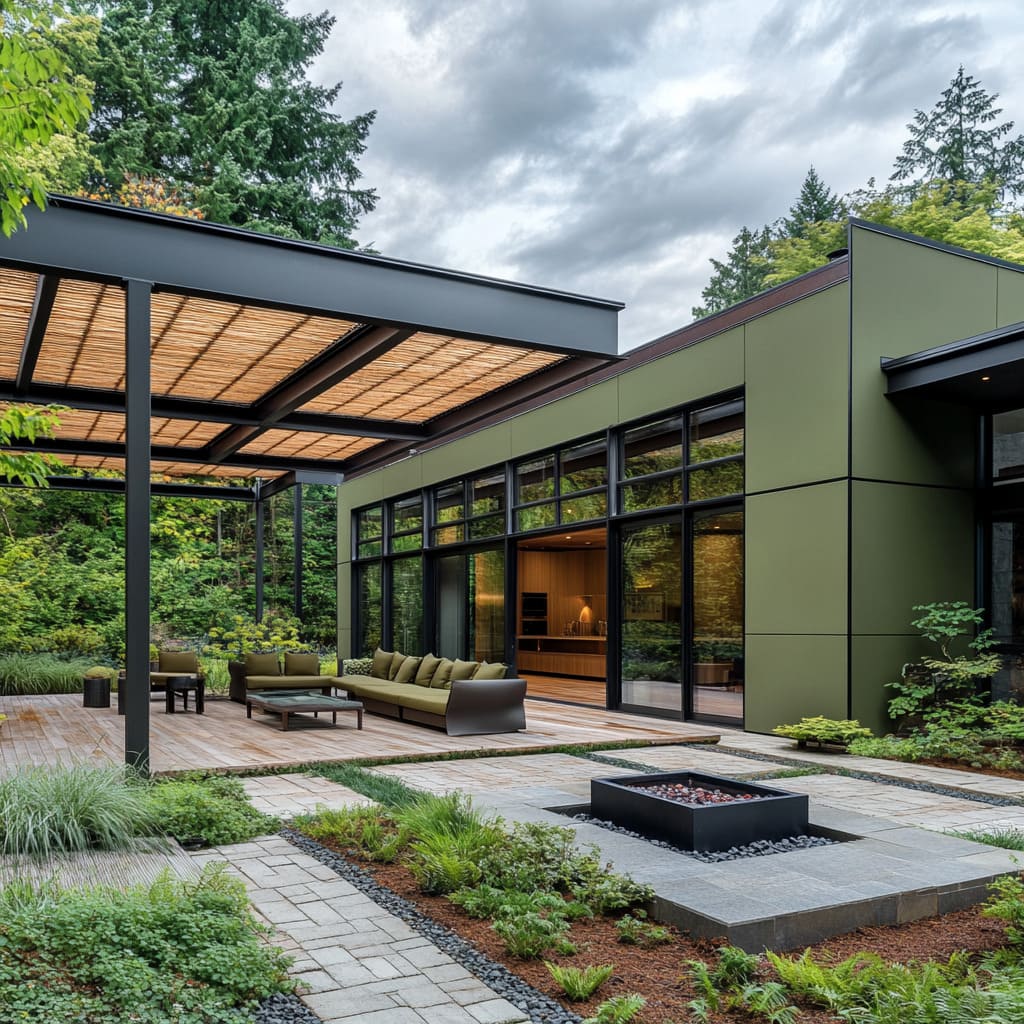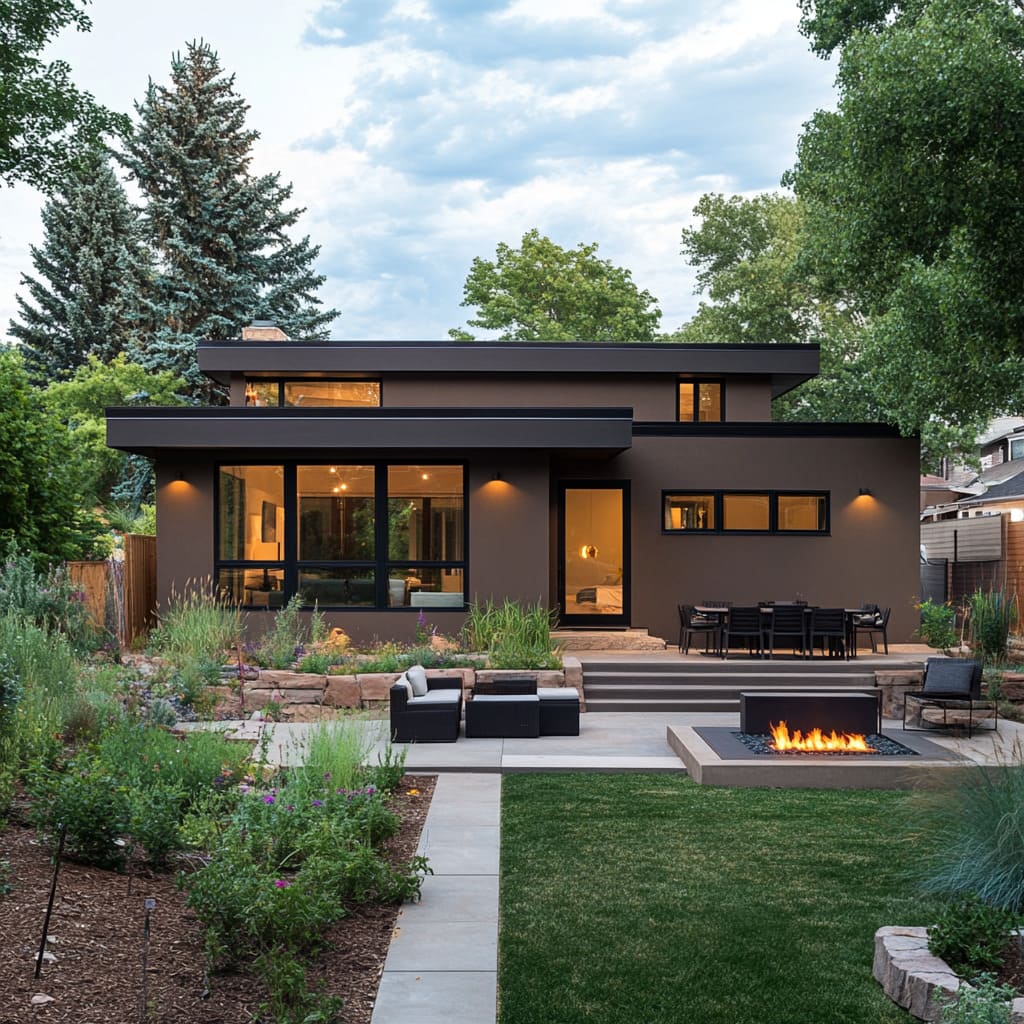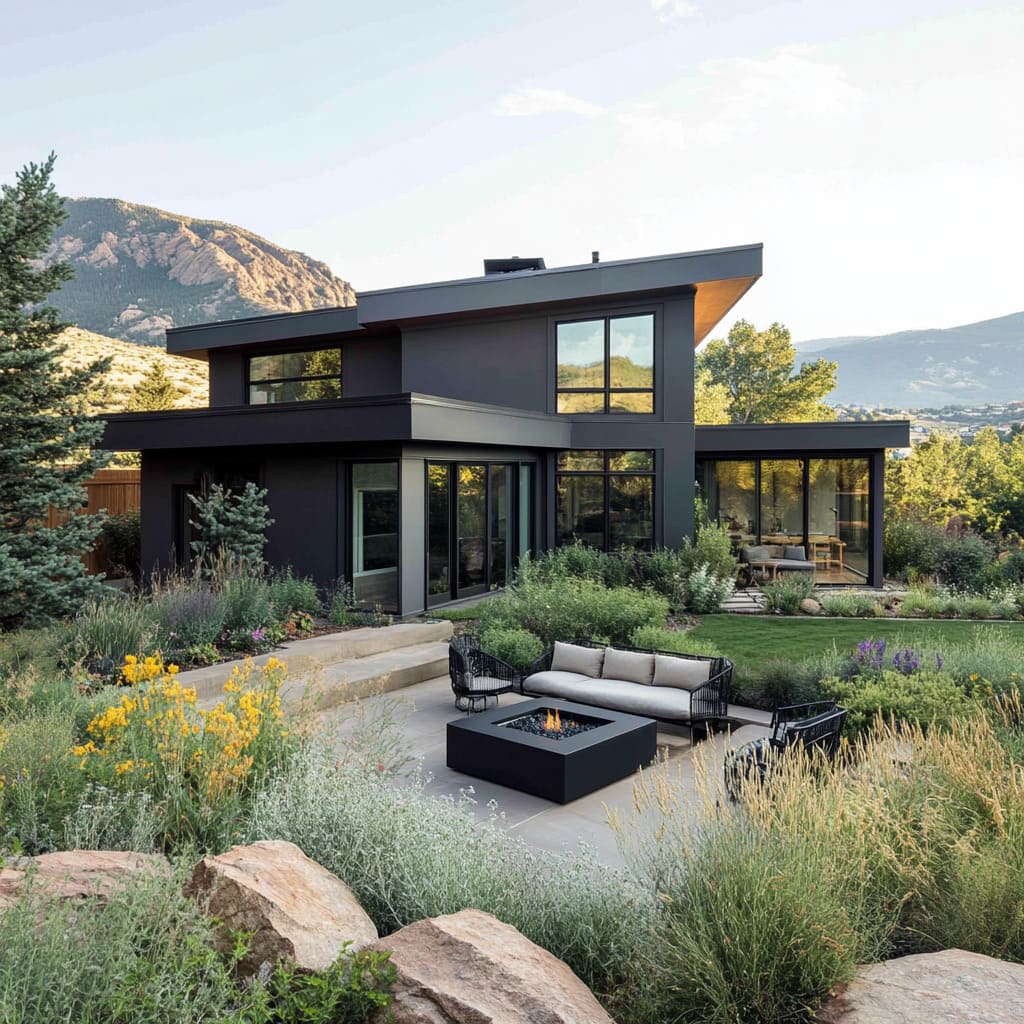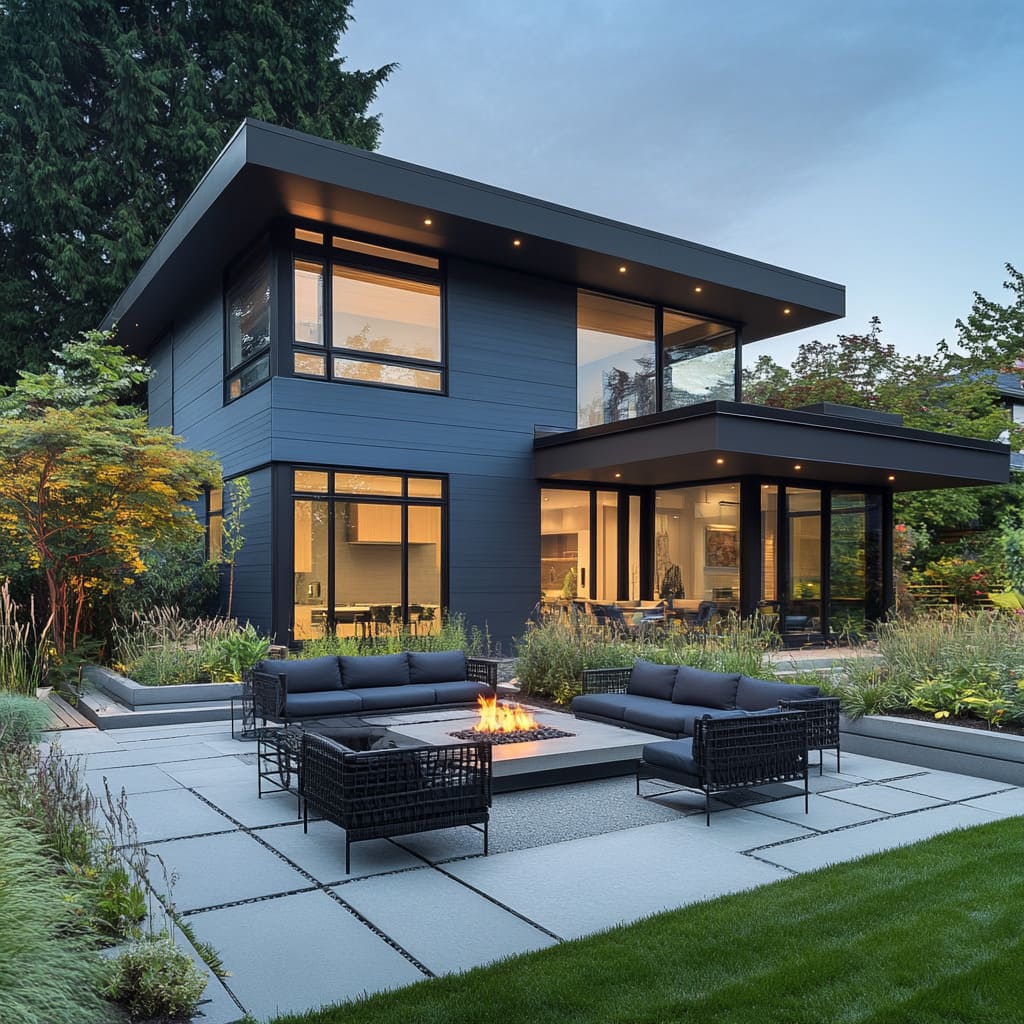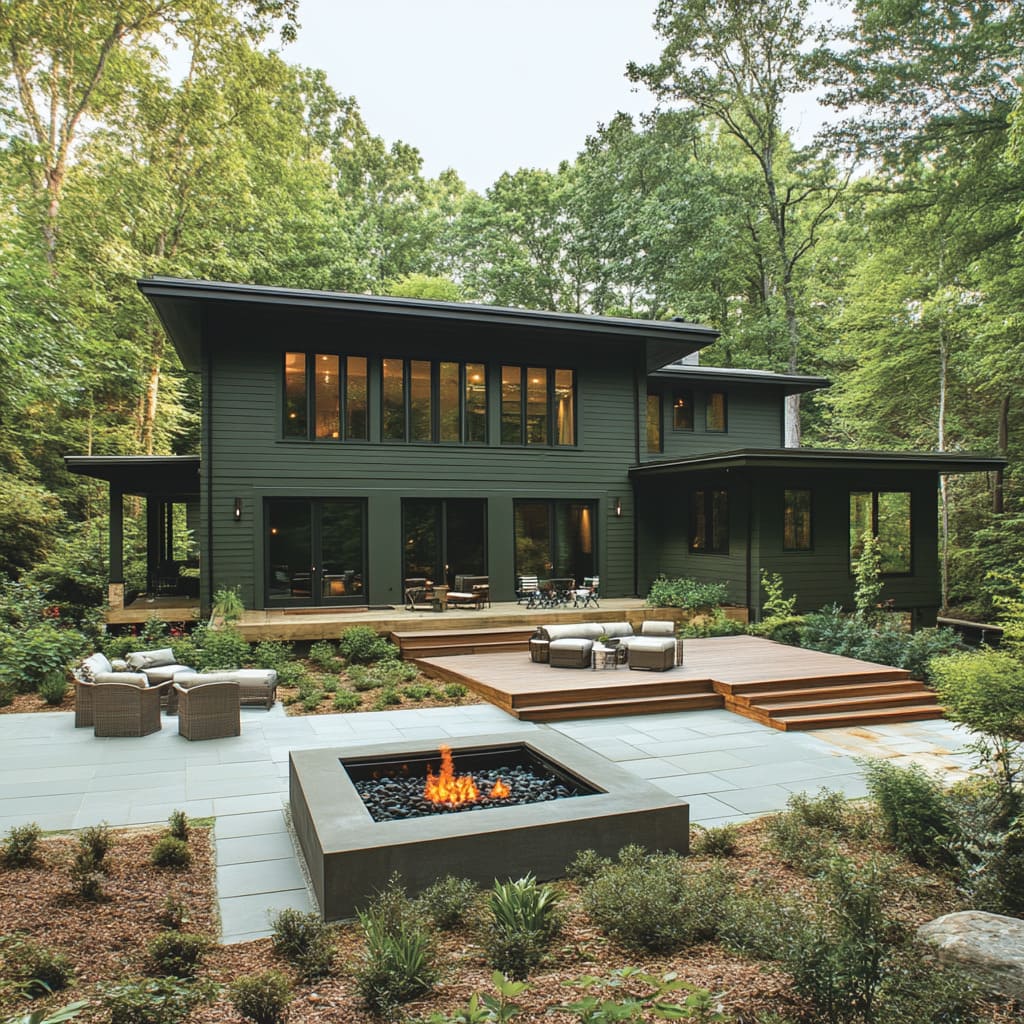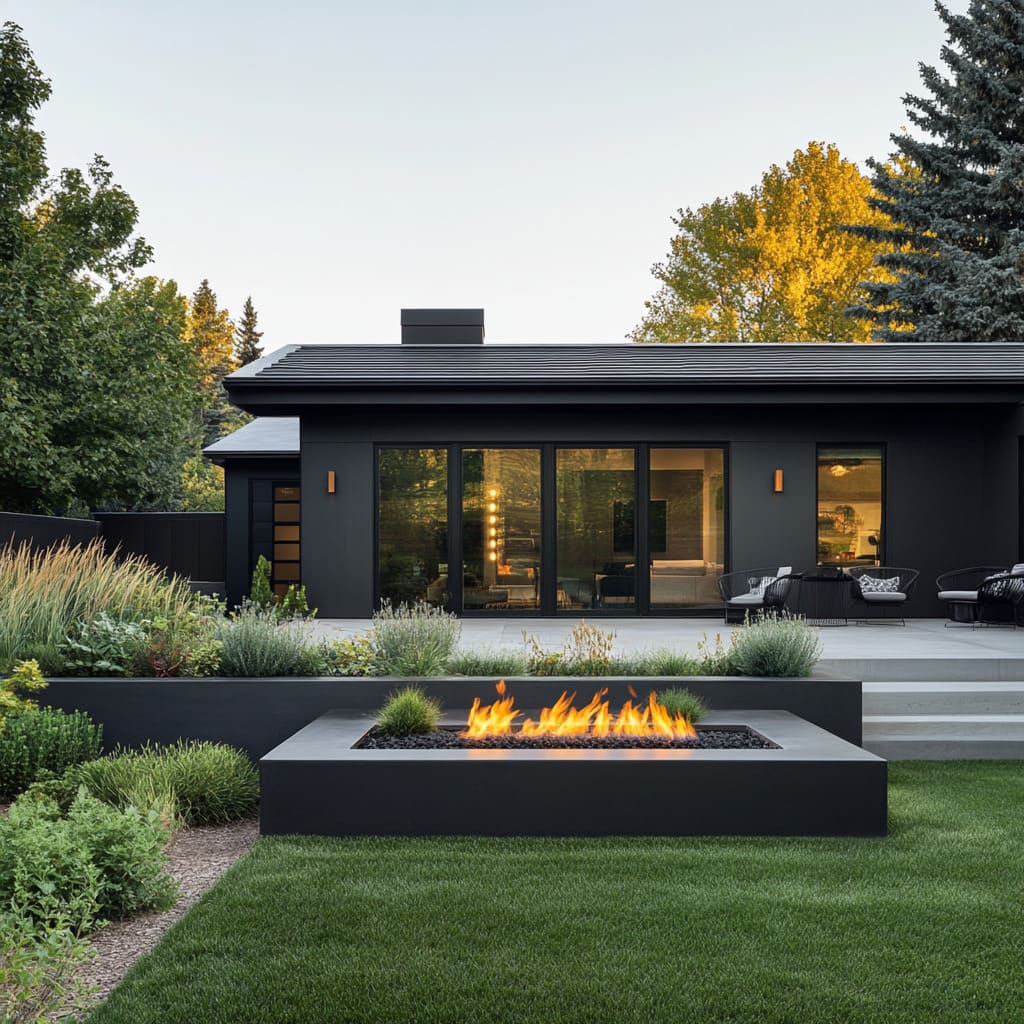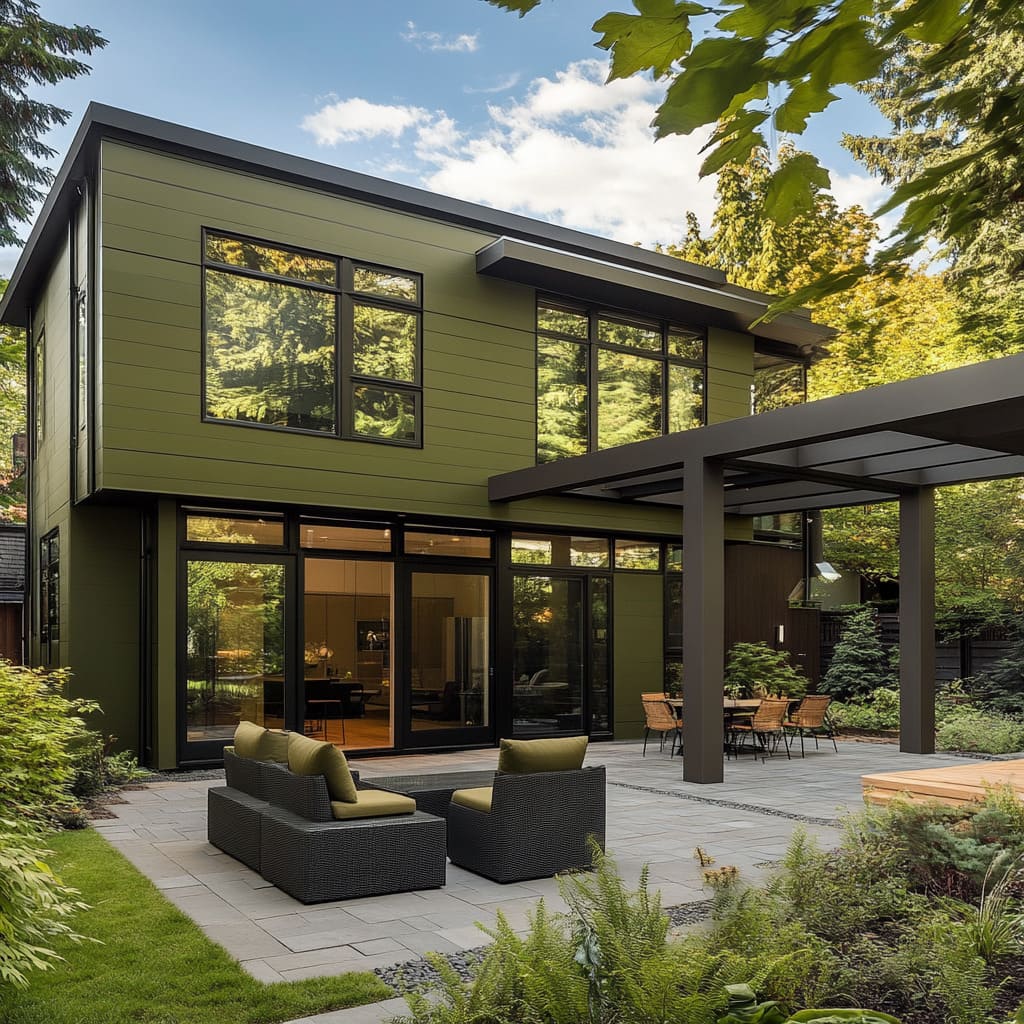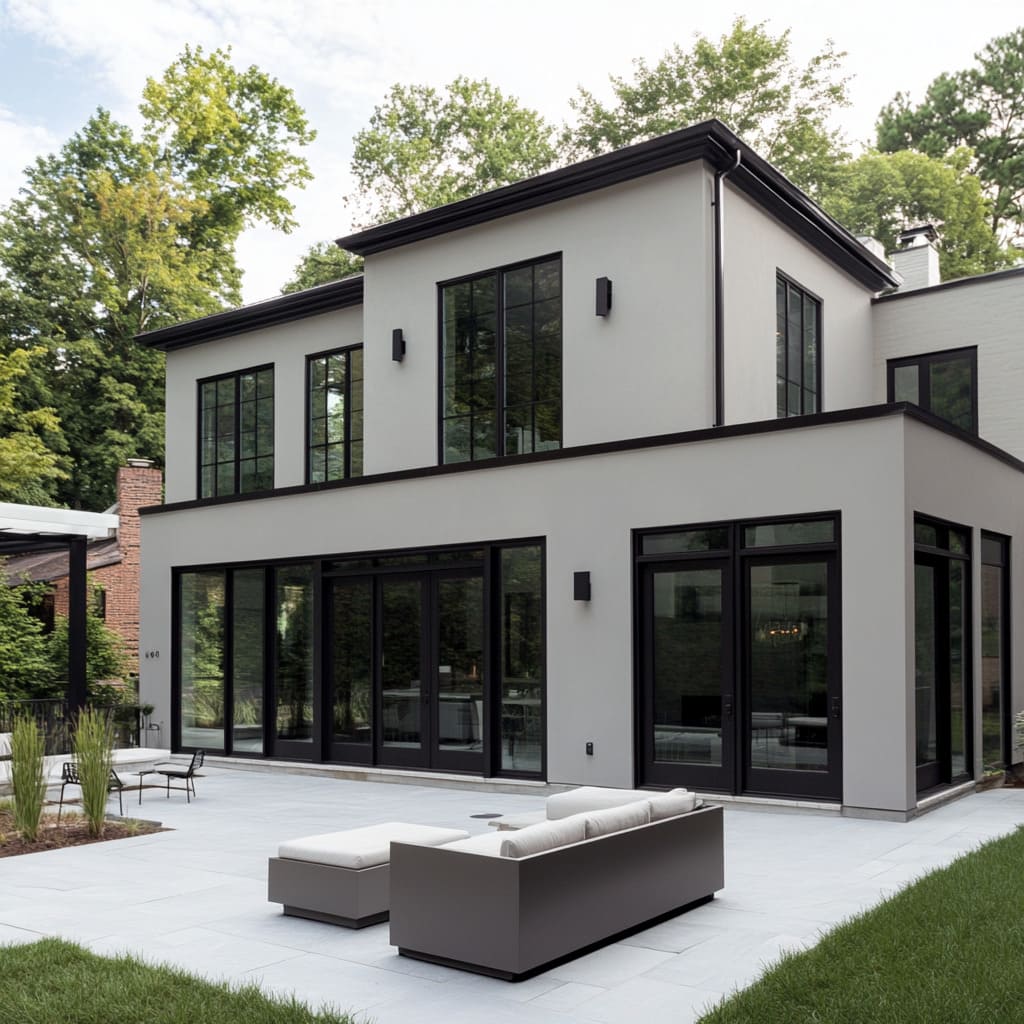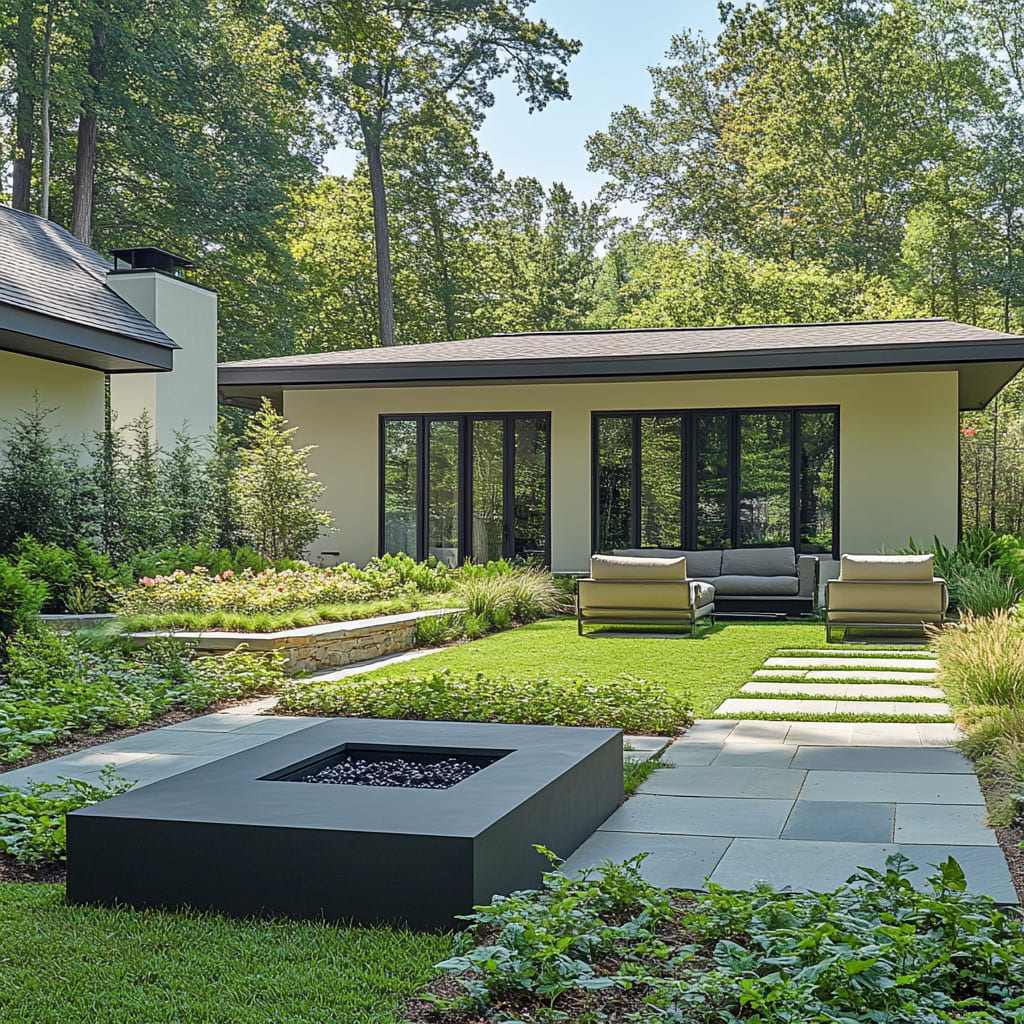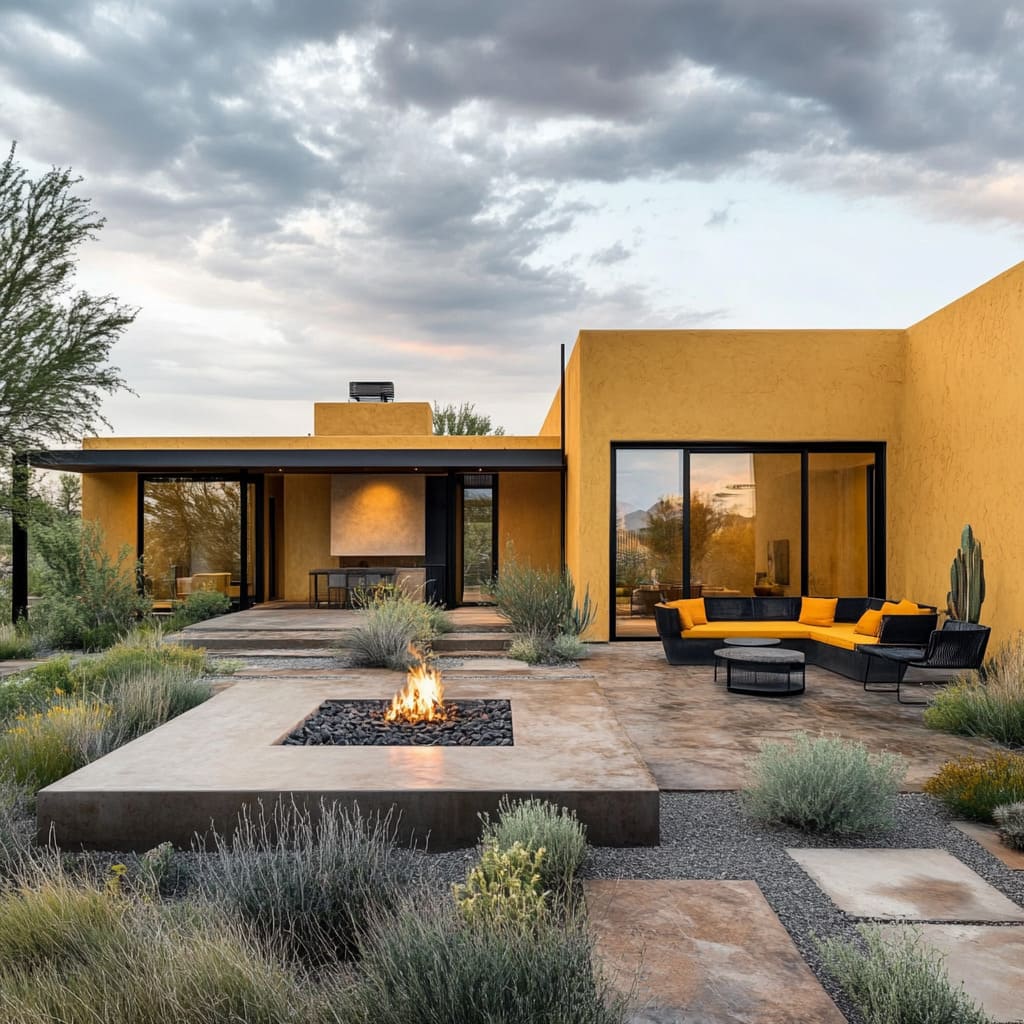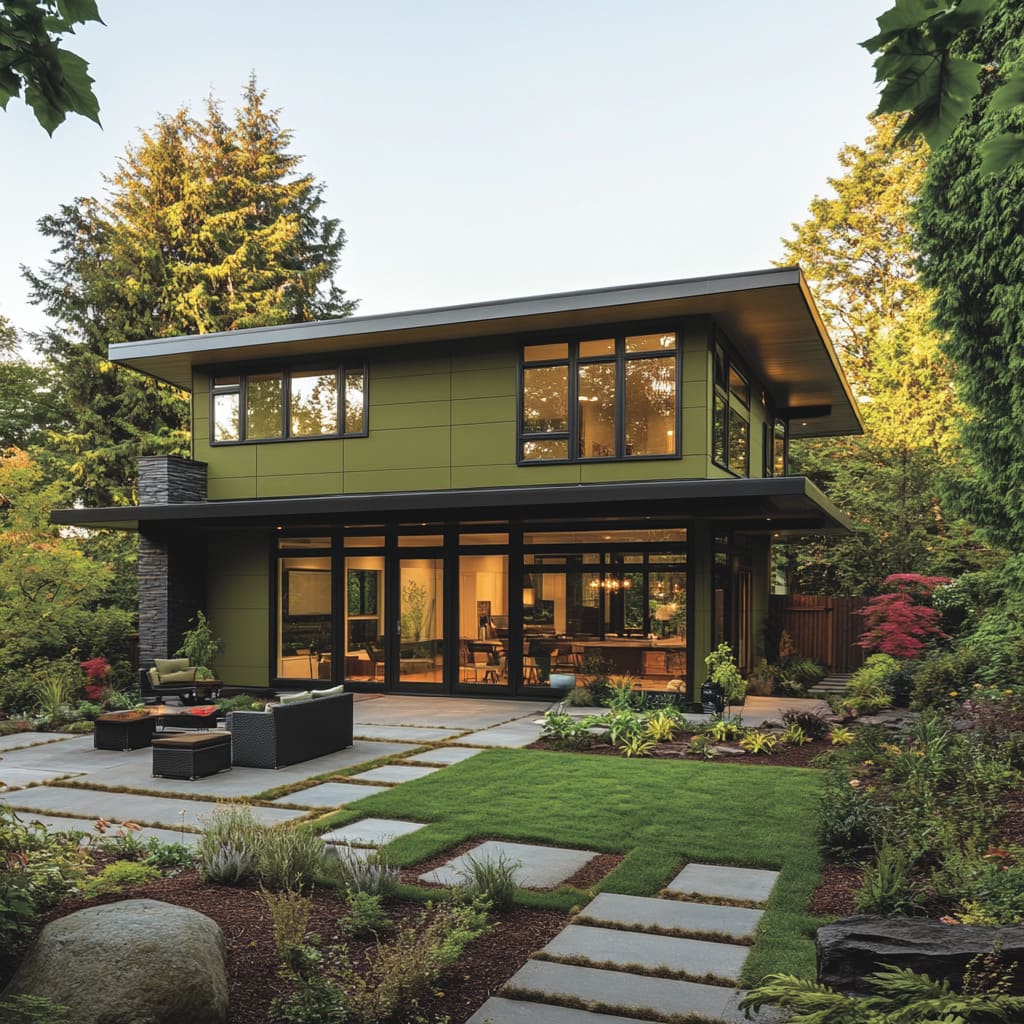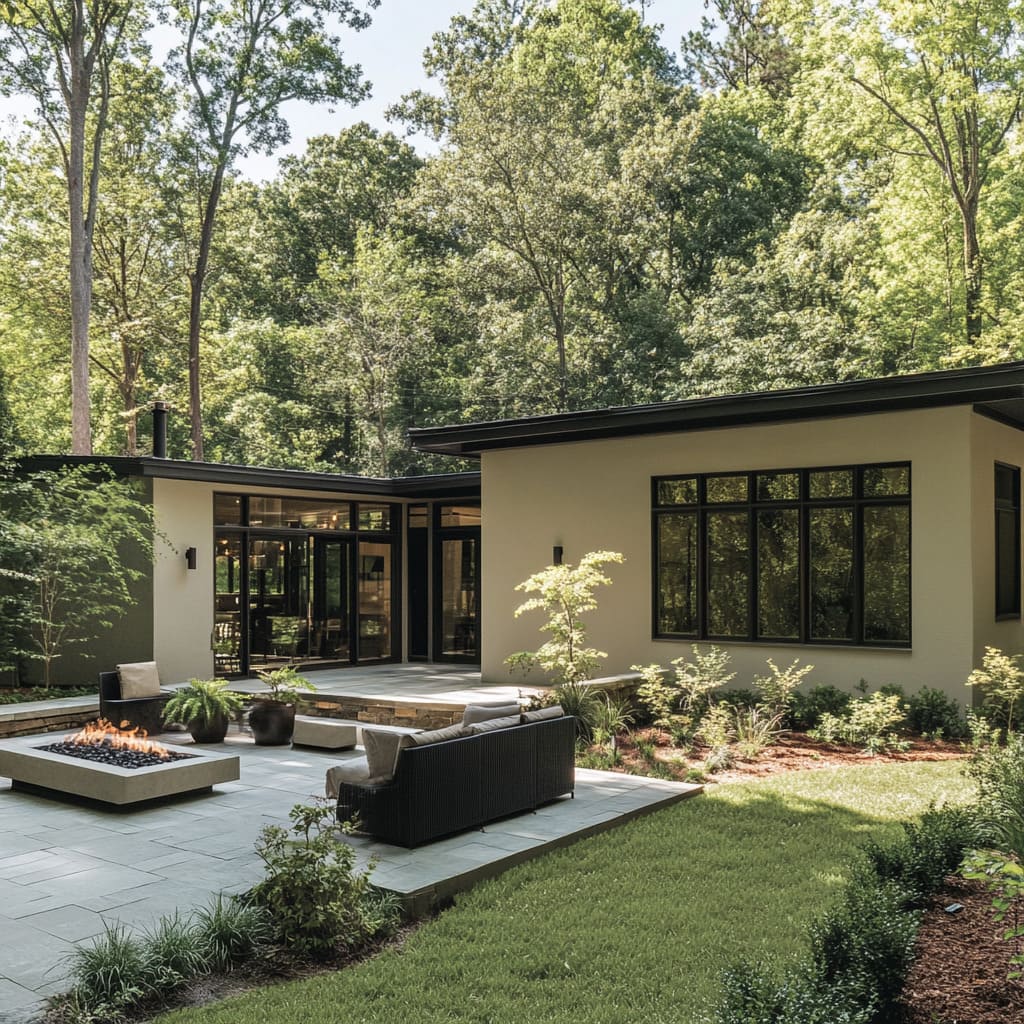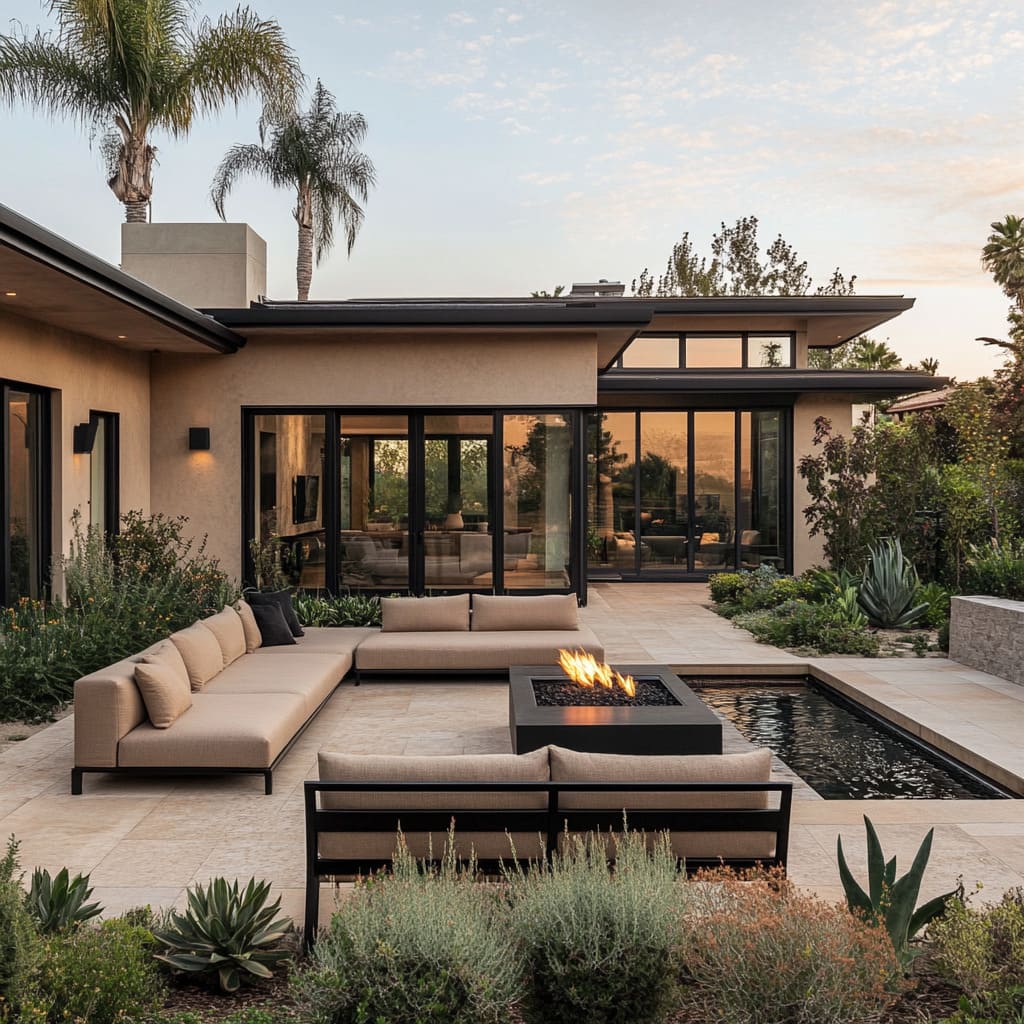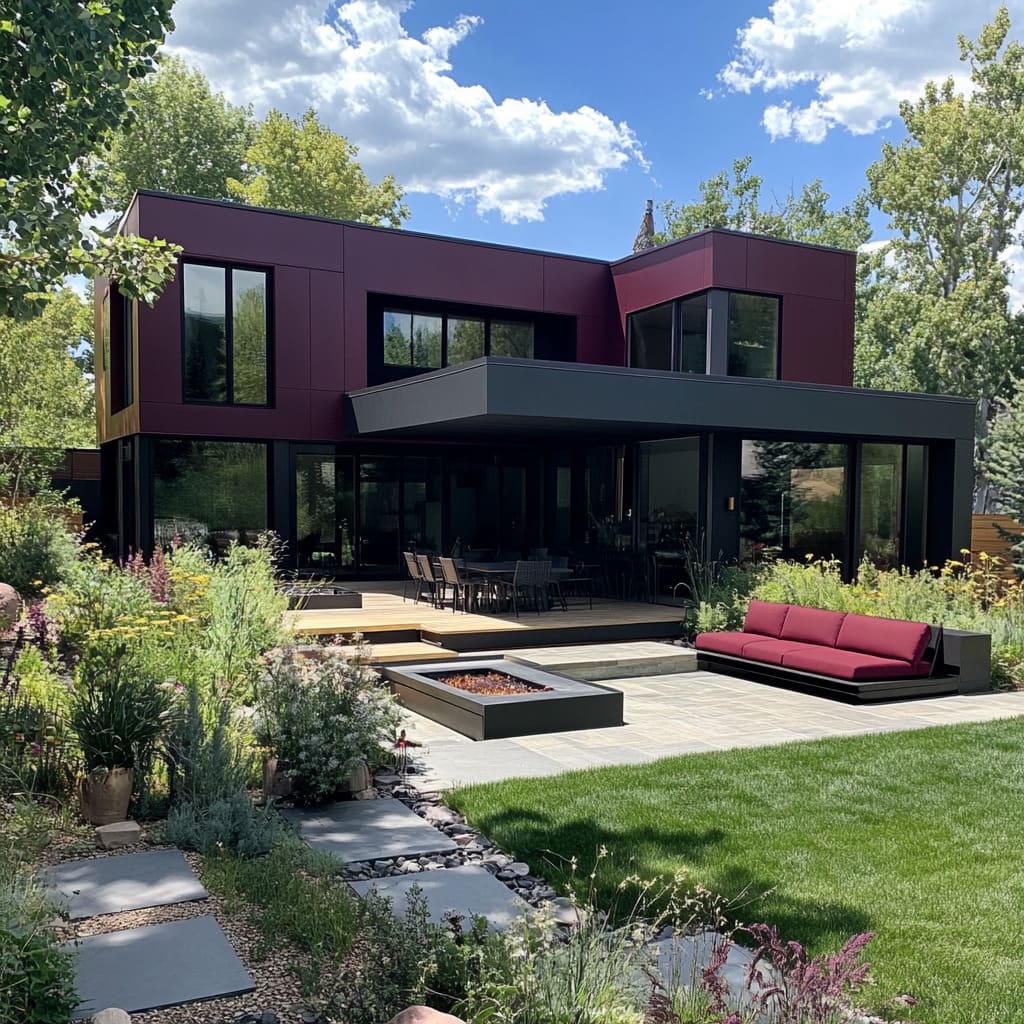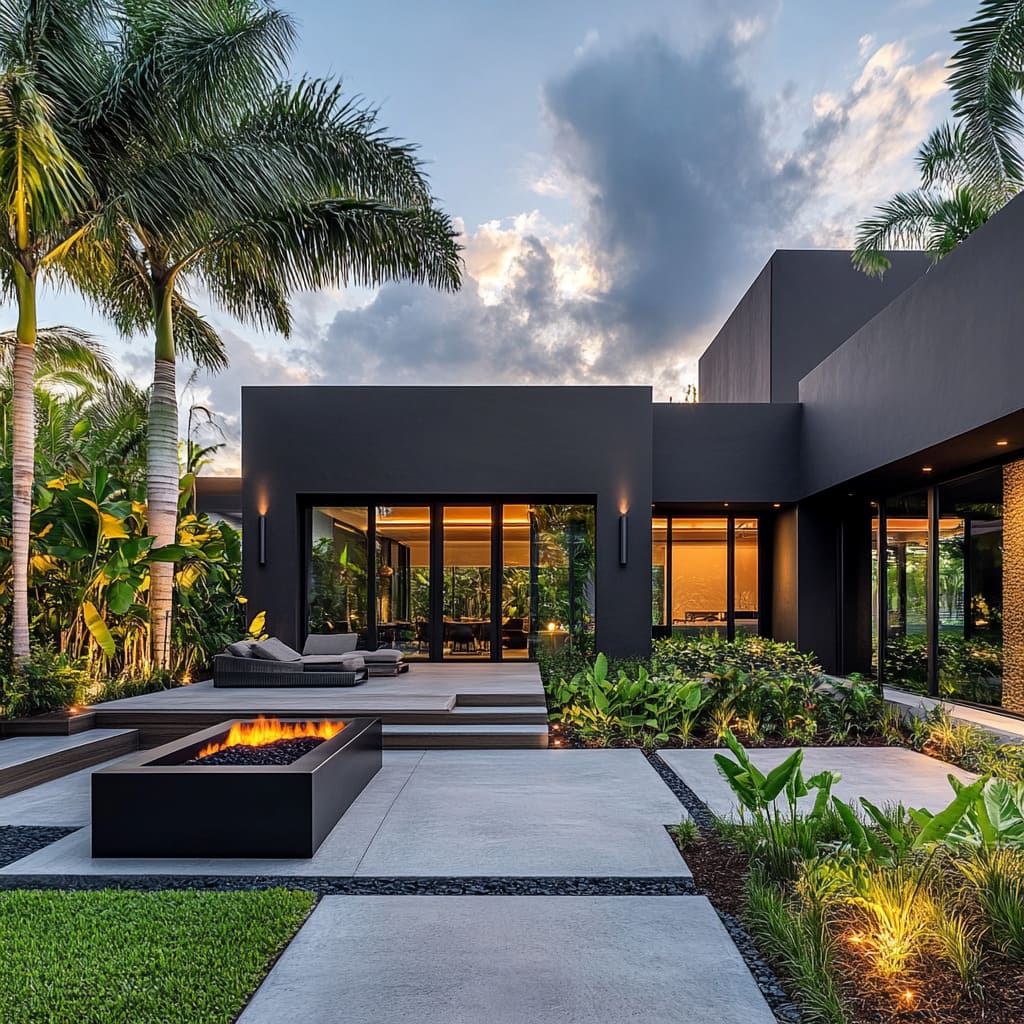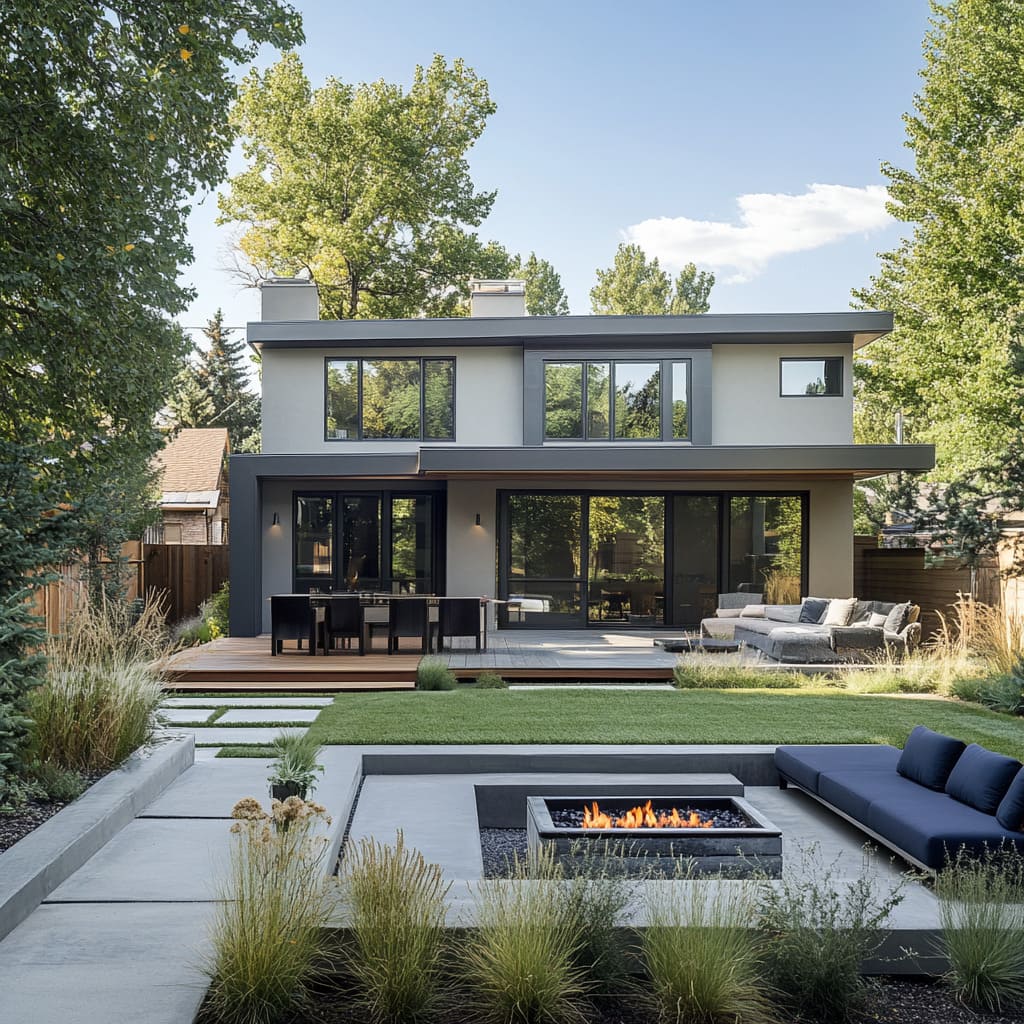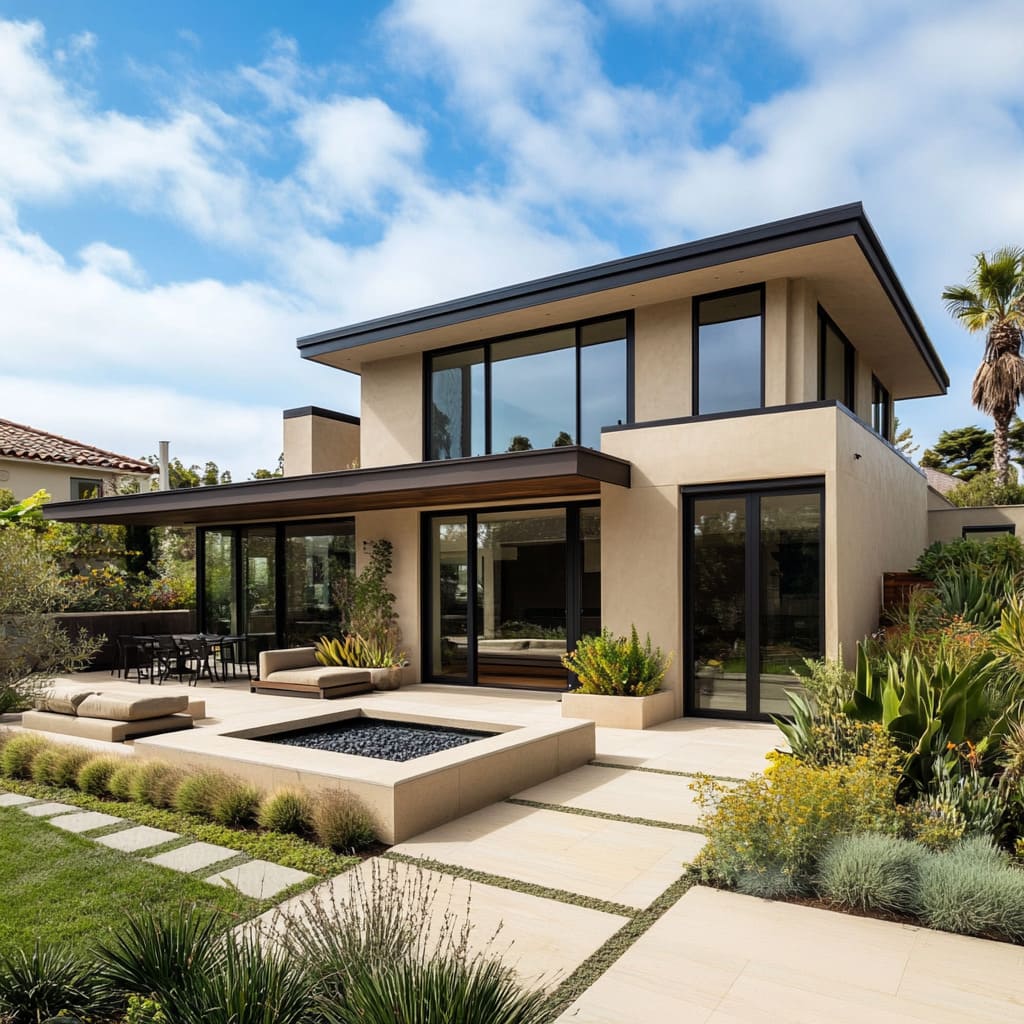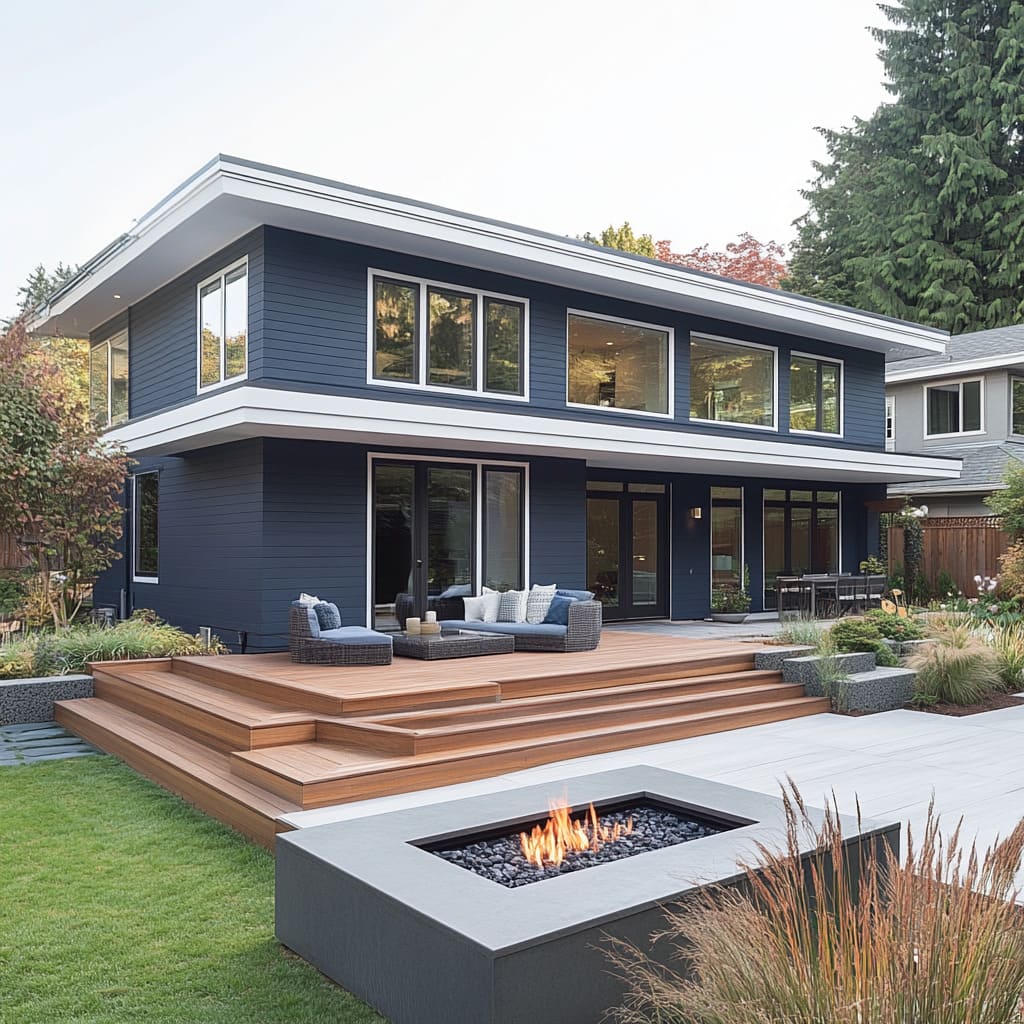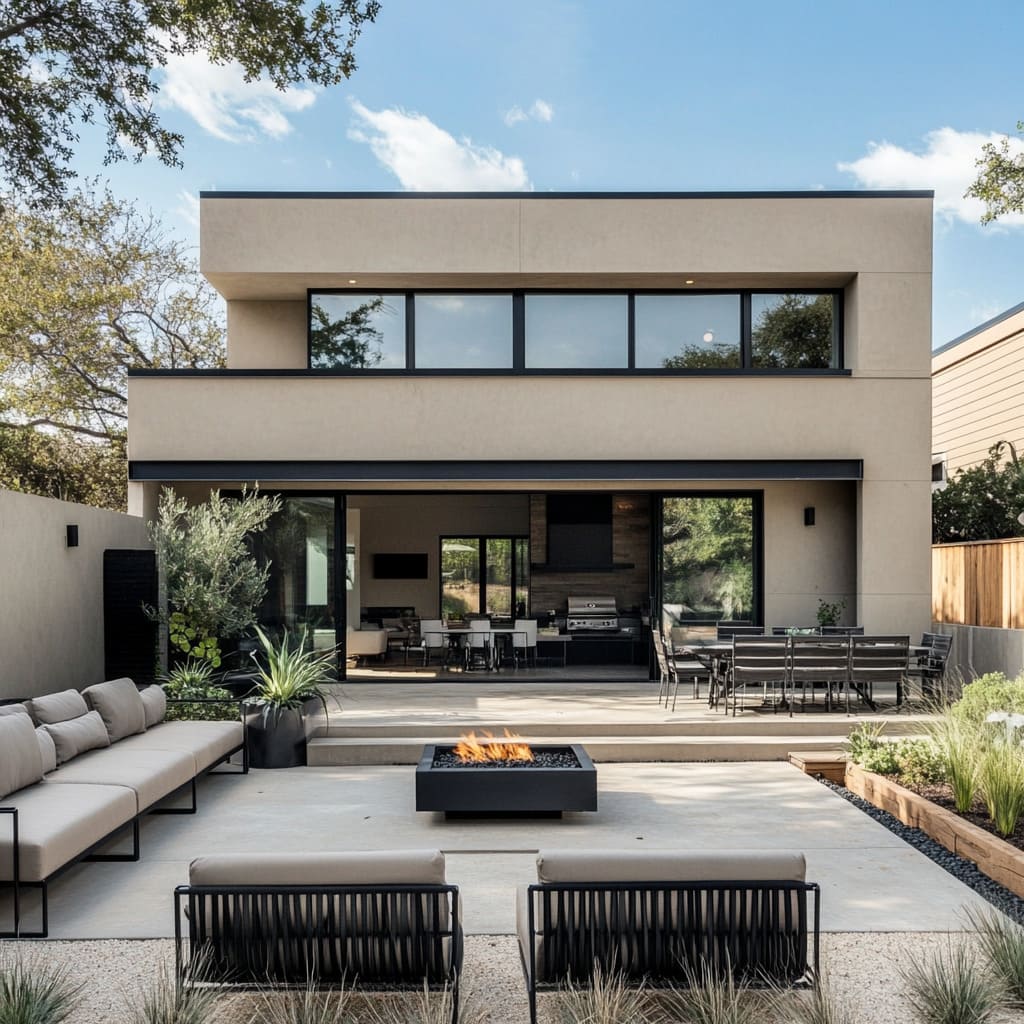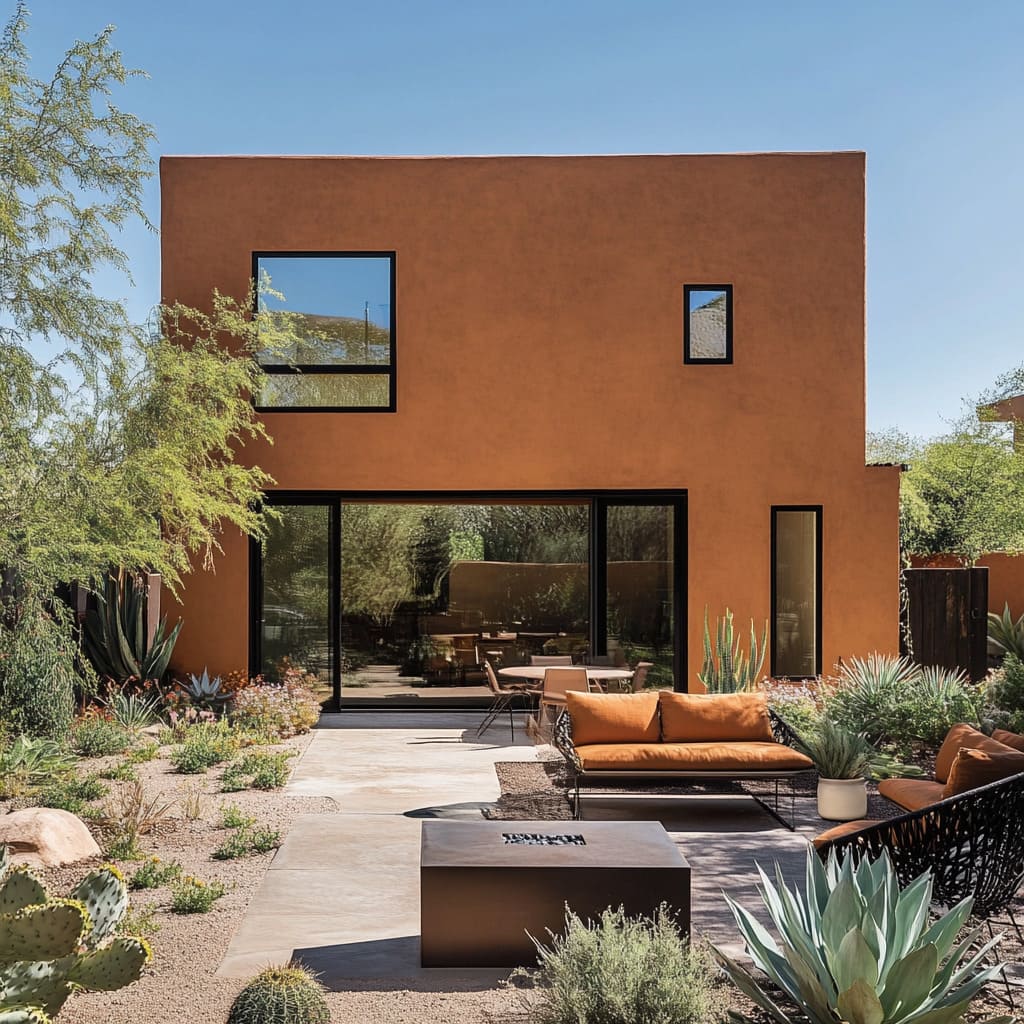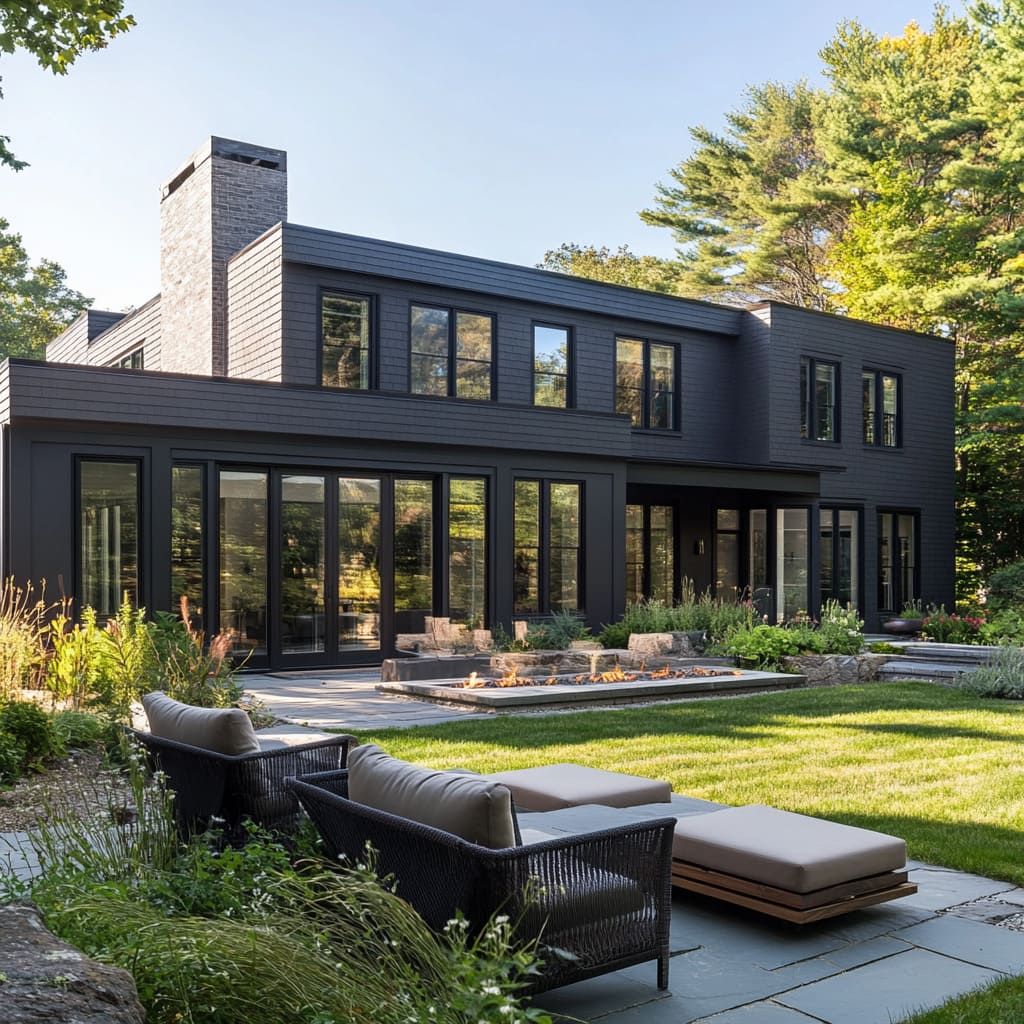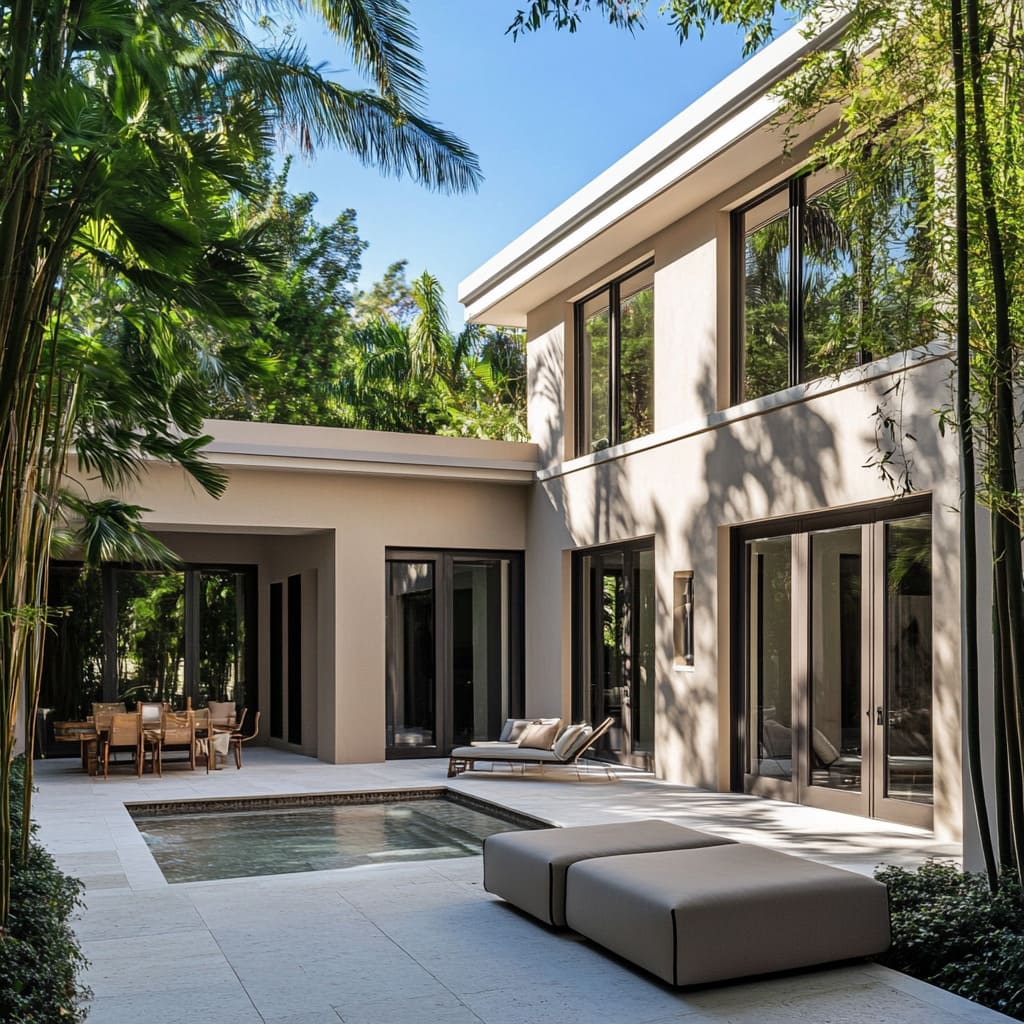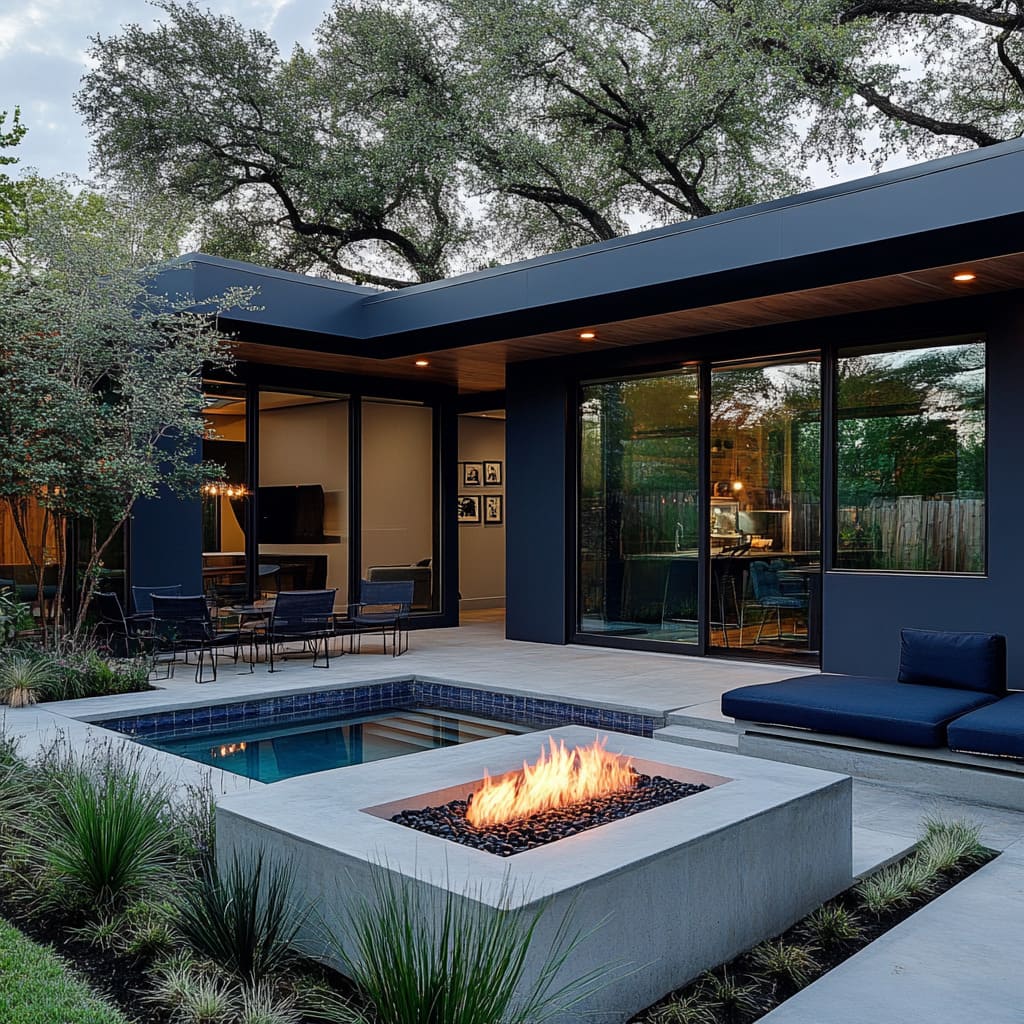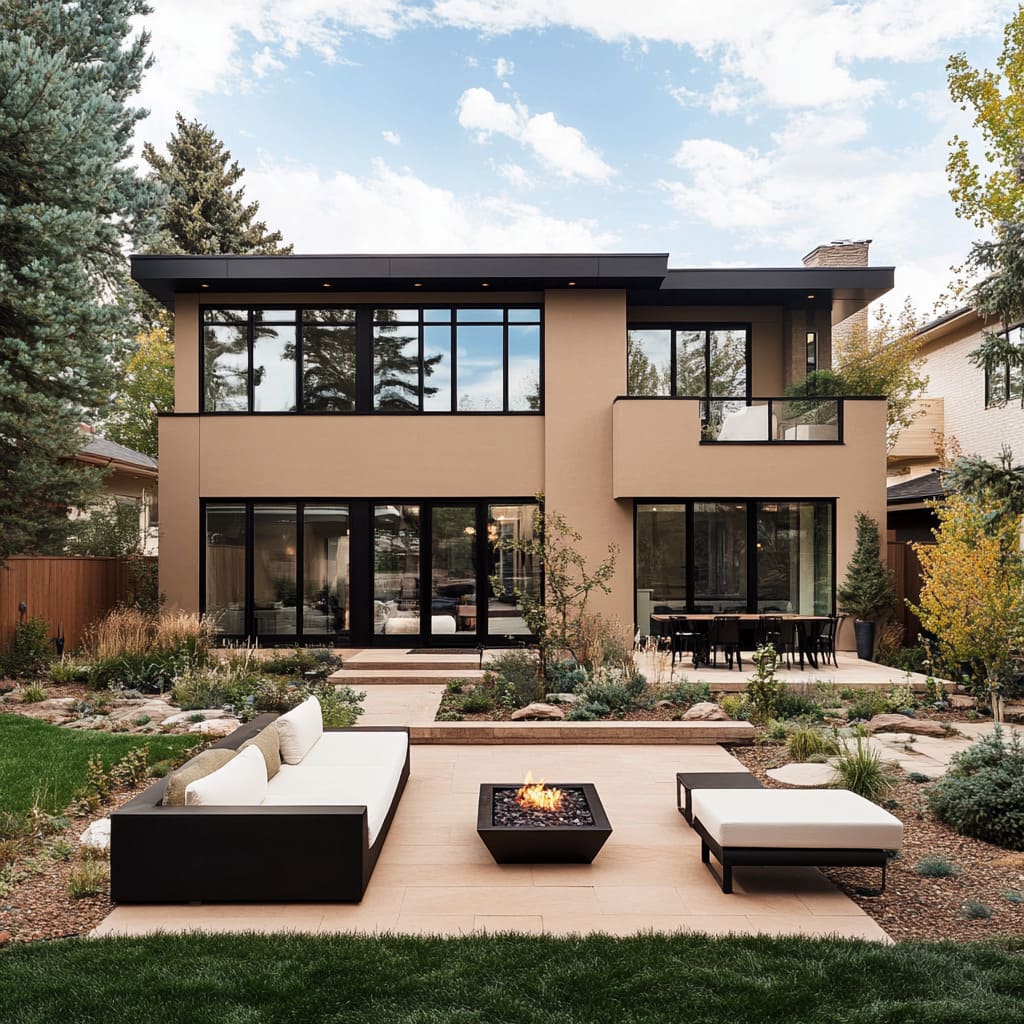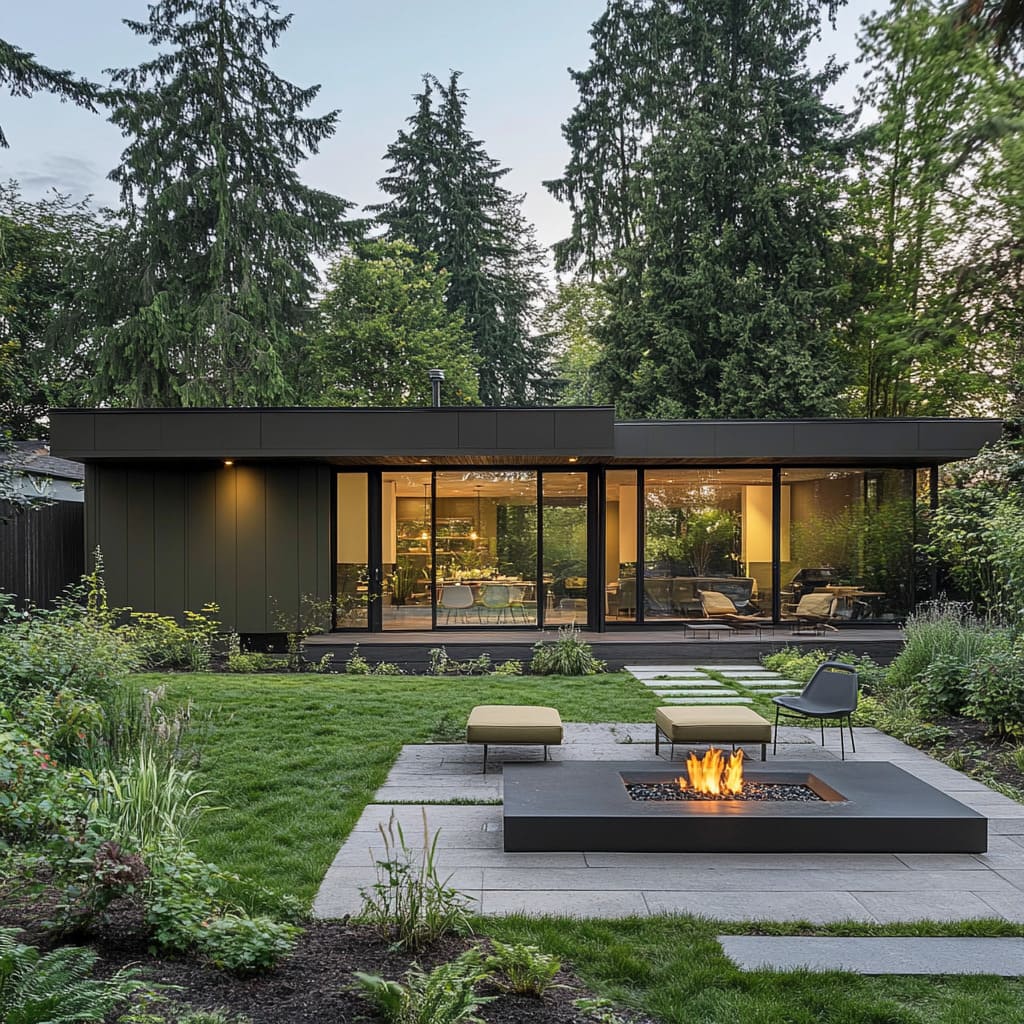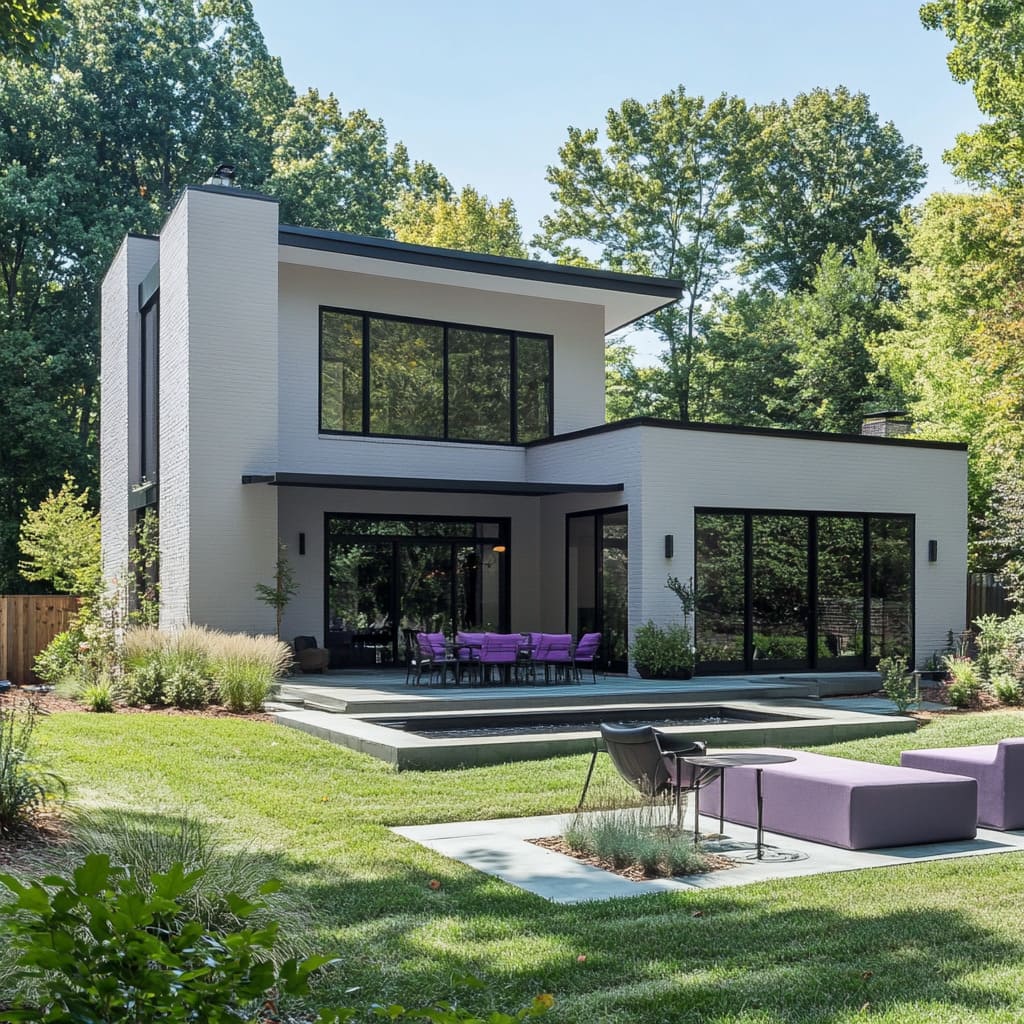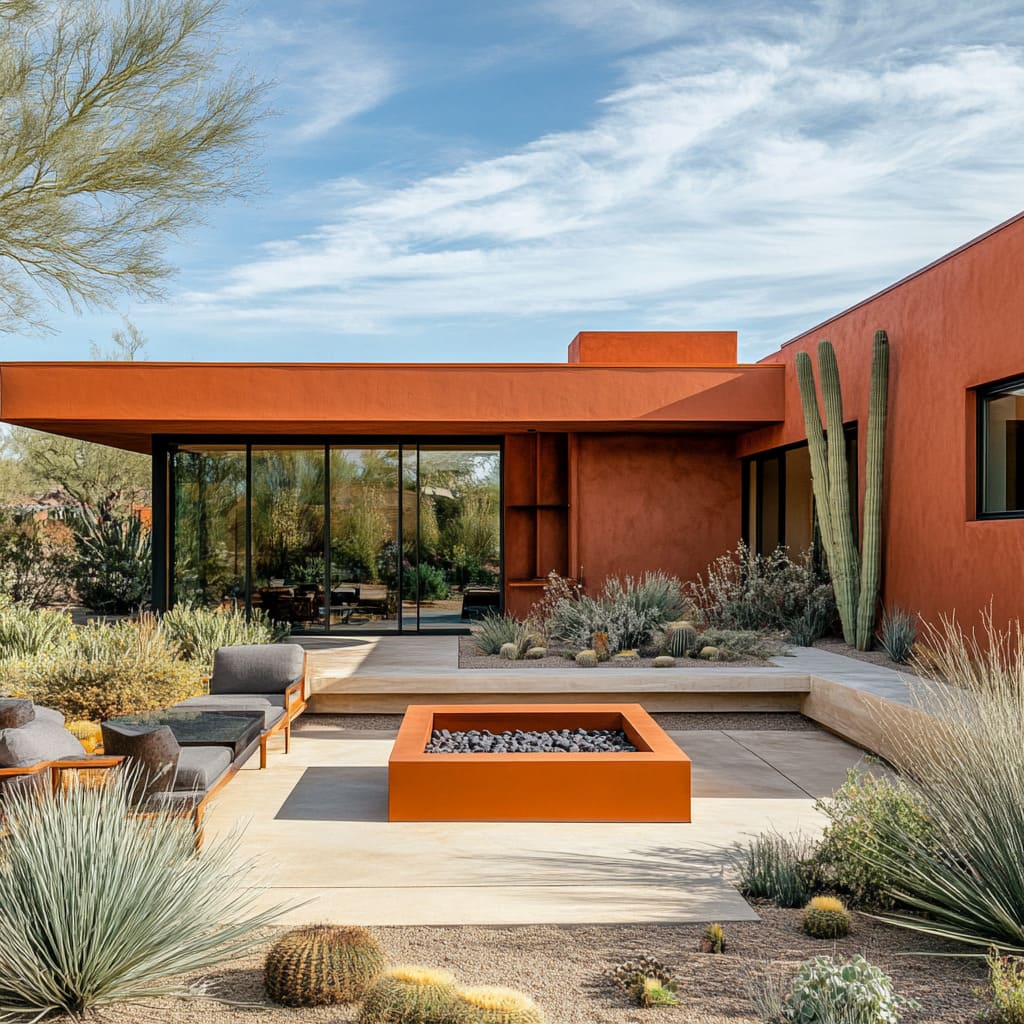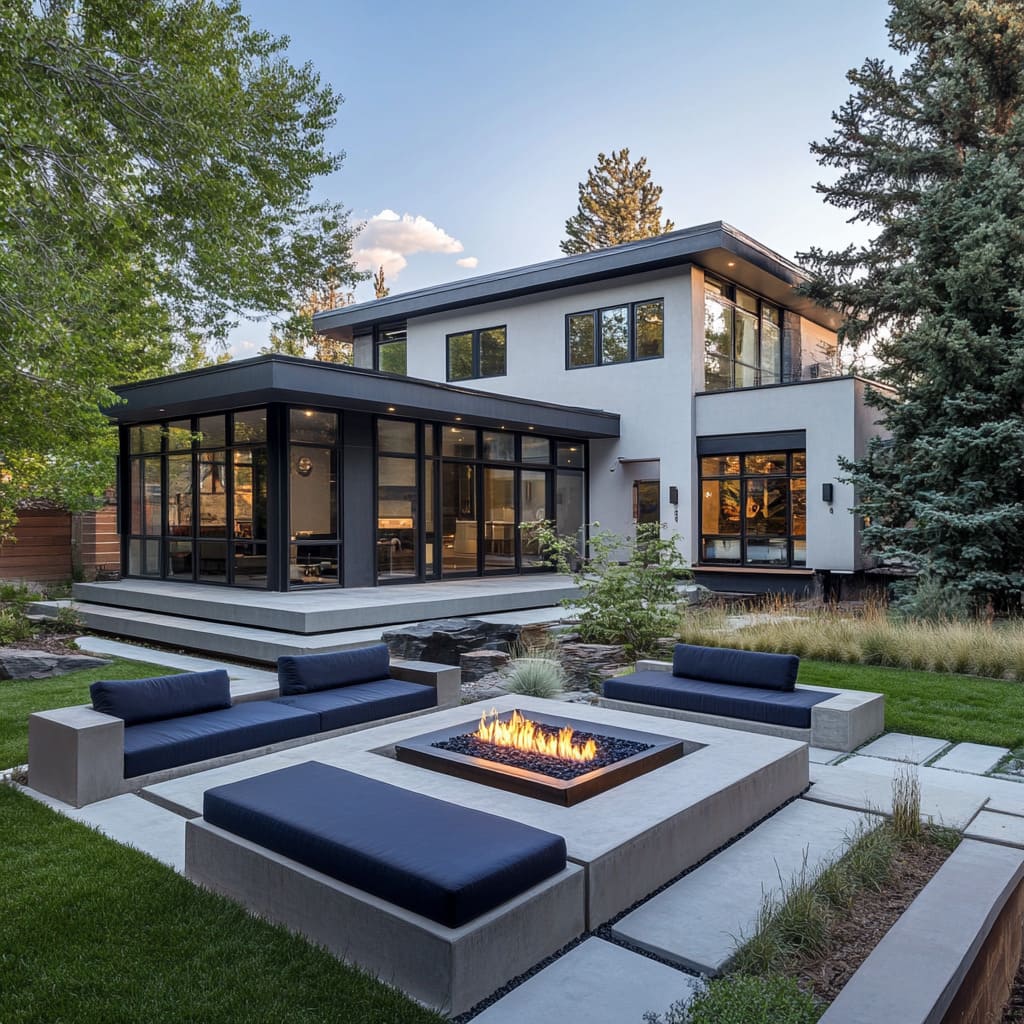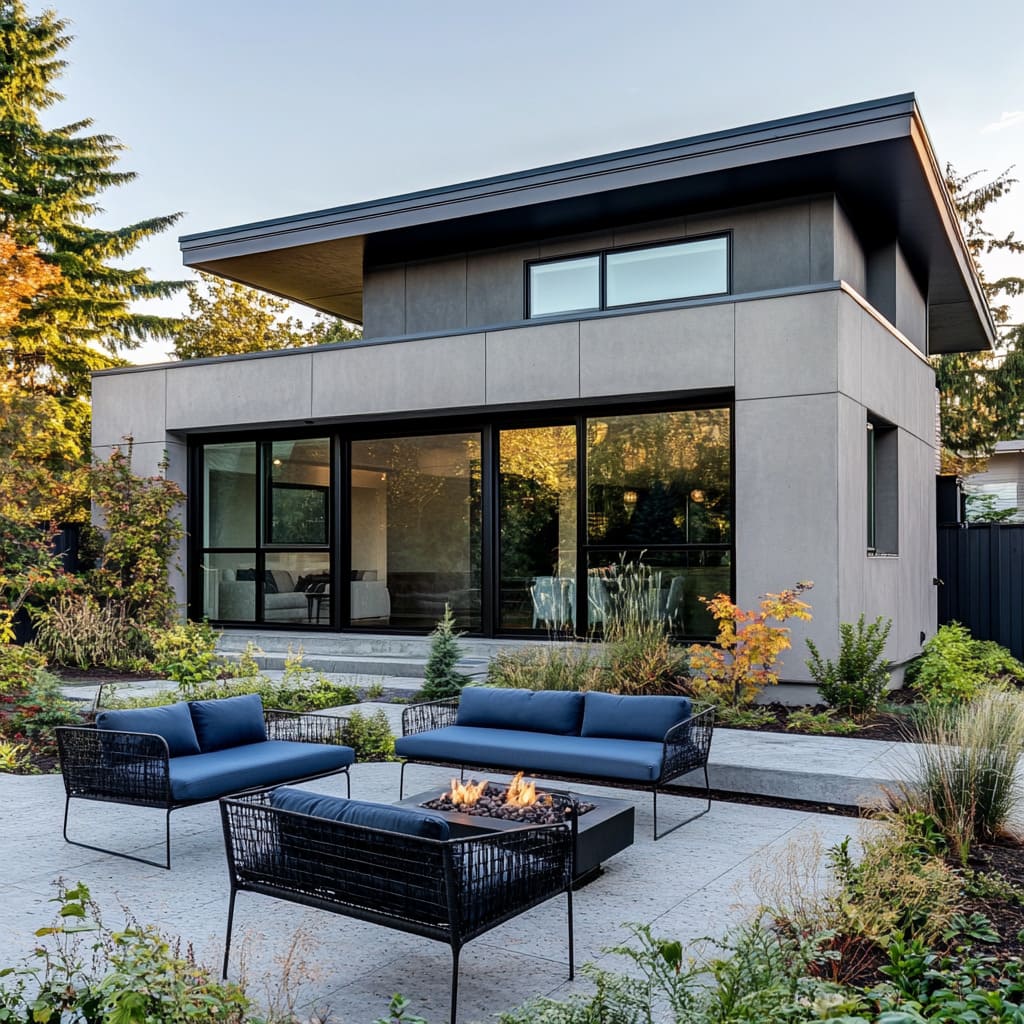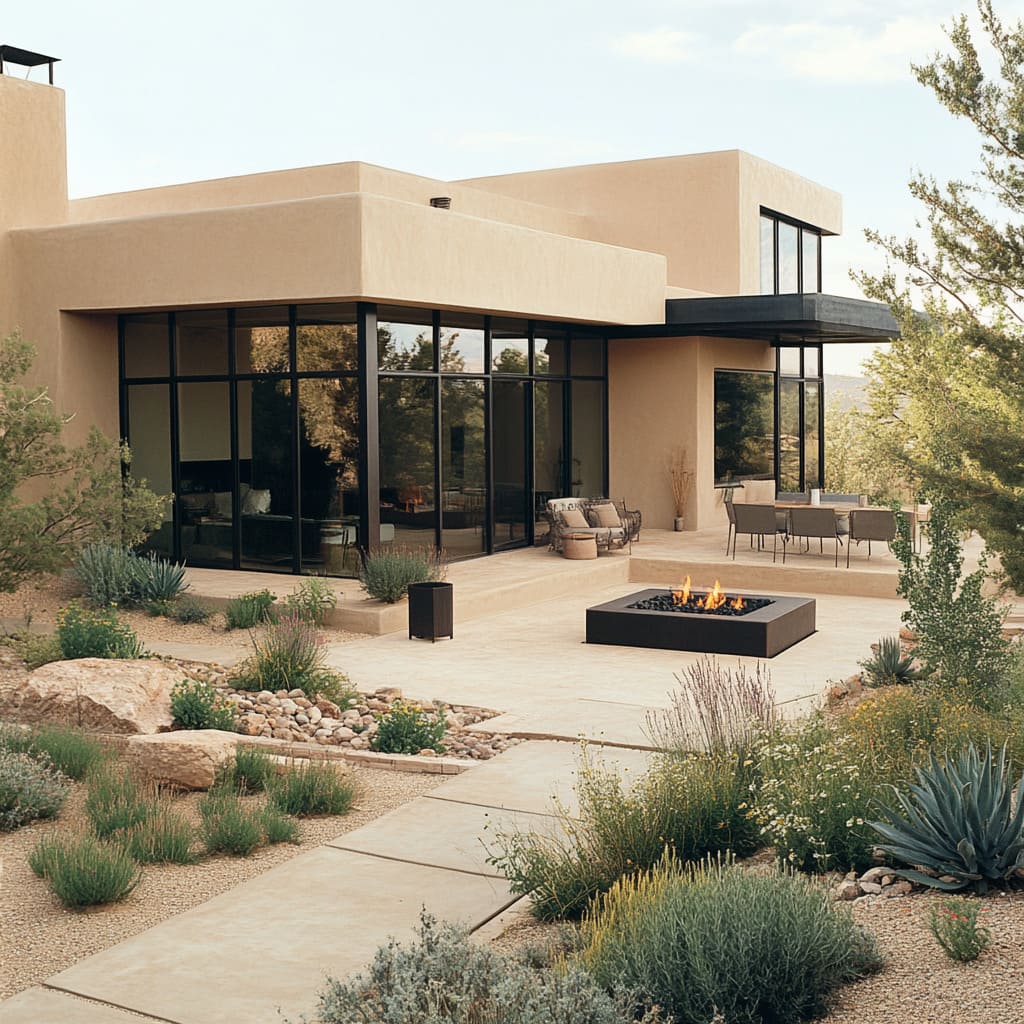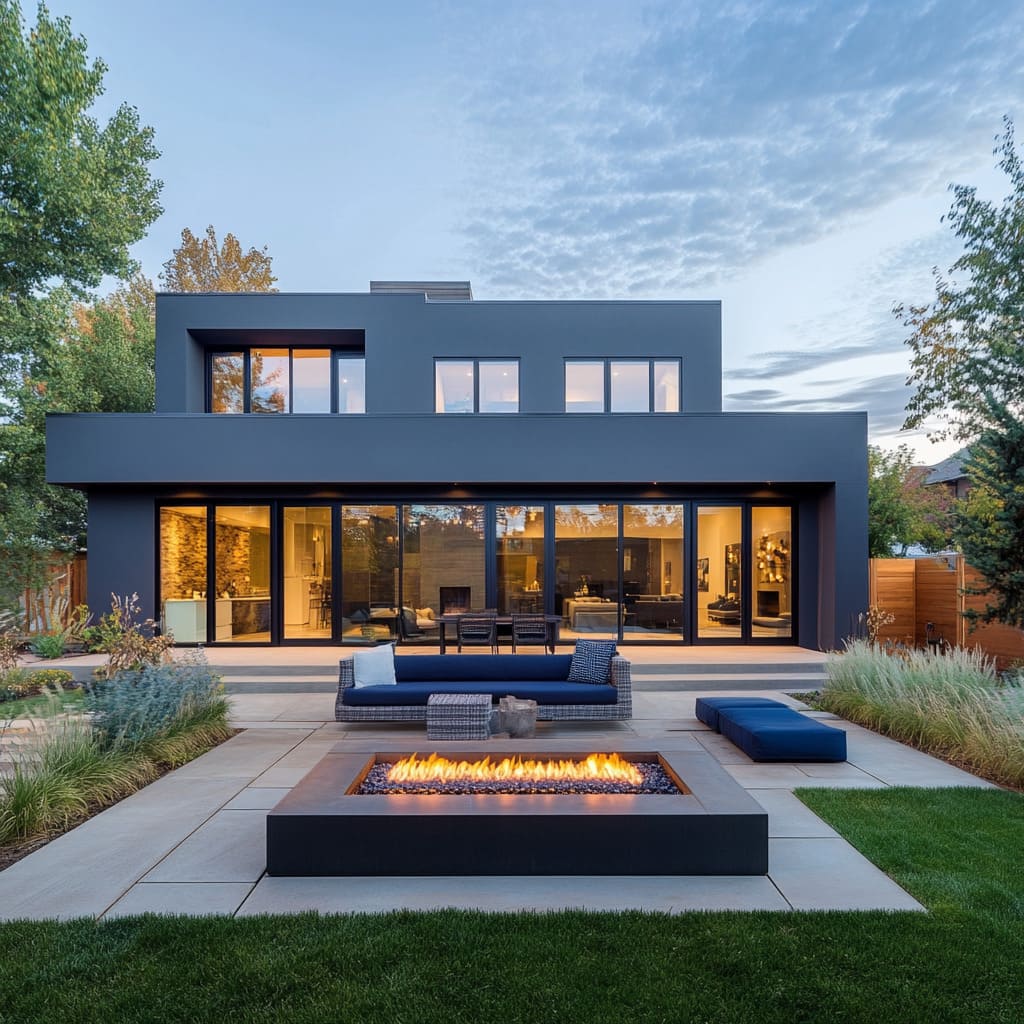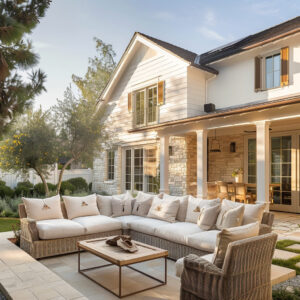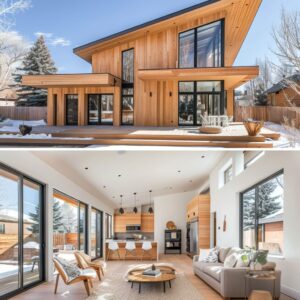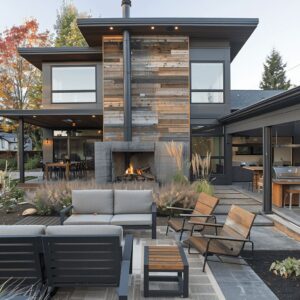Minimalist architecture, characterized by its clarity of form and intentional simplicity, continues to influence modern living environments around the globe. This architectural approach streamlines designs to their essential elements, removing non-essential forms, features, and concepts, leading to a purity of shape and an efficiency of space.
At its core, minimalist house design leverages simplicity, functionality, and aesthetic appeal to create spaces that are both visually tranquil and easy to maintain
Key Characteristics of Minimalist House Exteriors
Simplicity in Form
Minimalist homes are often defined by their clean lines and simple geometric shapes. The architecture doesn’t just discard the complexity but transforms spaces into visual poems that are straightforward and calming.
These homes often feature spacious, open layouts with a seamless flow from the interior to the exterior, enhancing the overall usability and aesthetic of the living space. The focus on horizontal and vertical lines interplays beautifully with natural light, creating dynamic visuals that change with the hours
Color Palette
The color schemes in modern minimalist house designs often rely on a monochrome palette, utilizing shades of white, beige, gray, and black. These colors underscore the architecture’s intent to create serene environments where the structures themselves become the center of visual interest without overwhelming sensory inputs.
The use of neutral tones helps in forging a timeless facade that works harmoniously with the natural surroundings, emphasizing permanence and stability
Materials and Textures
In creating minimalist home ideas, the choice of materials is pivotal. Materials like concrete, wood, metal, and glass are predominantly used for their ability to not only define the crisp, clean lines characteristic of minimalist design but also for their practical benefits.
Concrete offers durability and a smooth textural quality that complements minimalist aesthetics, while wood provides warmth and a tactile contrast to the coolness of metal and glass. These materials are selected for their functionality and longevity, ensuring the home is both beautiful and easy to care for, reducing the need for frequent maintenance
The adoption of minimalist architecture in home design emphasizes a lifestyle that appreciates the beauty in simplicity, functionality, and harmonious living. These homes stand as beacons of tranquility and practicality in the often chaotic world, providing spaces that are not only easy to maintain but also promote a calm and orderly way of living
Design Elements of Minimalist Exteriors
Flat and Shed Roofs
The architectural design of minimalist modern homes often features flat or slightly sloped roofs, a choice that underscores the aesthetic and functional aims of minimalism. Flat roofs provide a clean, horizontal line that enhances the visual simplicity of the structure, making the building itself a focal point without unnecessary ornamentation
Similarly, shed roofs with their single, sloping surfaces contribute to a streamlined look while facilitating water drainage and offering an opportunity to incorporate skylights or solar panels without disrupting the home’s sleek silhouette. These roofing choices not only define the minimalist aesthetic but also support sustainable building practices by optimizing energy efficiency
Large Windows and Glass Doors
In minimalist tiny house designs, the inclusion of large windows and expansive glass doors is integral to dissolving the barriers between indoors and out. This architectural feature maximizes the entry of natural light, vital for creating open, airy interiors that feel connected to their surroundings.
The transparency facilitated by such installations encourages a visual and practical flow between the home’s interior and the landscape, extending living spaces outward and inviting the calmness of nature inside. The strategic placement of windows and doors enhances not only the functionality of living spaces but also contributes to energy efficiency by reducing the need for artificial lighting during the day
Subtle Contrasts
In the realm of concrete minimalist house design, employing subtle contrasts in color and material can significantly enhance architectural details without compromising the home’s simplistic ethos. For instance, a dark-colored frame on windows or doors can outline views and highlight the clean geometry of the structure, creating depth and focus.
Similarly, mixing materials such as smooth concrete with natural wood or metal can introduce textural diversity that enriches visual interest while maintaining a unified look. These contrasts are thoughtfully selected to accentuate features without leading to visual clutter, adhering to the minimalist principle that less is more
By focusing on these design elements, minimalist house exterior ideas prioritize clarity, functionality, and integration with the environment. Each choice, from the shape of the roof to the materials used, is made with an eye toward creating a harmonious, efficient, and inviting home
Integration with Natural Surroundings
Landscape Design
In the context of minimal house exterior aesthetics, the integration of the structure into its natural surroundings is crucial. This is achieved through the strategic use of native plants and organic landscaping techniques that complement the minimalist philosophy.
By selecting flora that naturally thrives in the local environment, minimalist homes can blend seamlessly into the landscape, enhancing the beauty of both the architecture and its setting. The choice of low-maintenance, native plants not only reduces the environmental impact but also strengthens the connection between the home and its natural surroundings, creating a harmonious visual continuity
Sustainable Features
Modern minimalist design house models incorporate sustainable features that capitalize on the natural environment to enhance energy efficiency. Key among these features are passive solar heating and natural cooling systems.
Passive solar heating is achieved by orienting the home to maximize sunlight penetration during colder months while minimizing it during warmer periods, utilizing materials that absorb and radiate heat. Natural cooling, on the other hand, involves strategic window placement and ventilation strategies to cool the home efficiently without mechanical air conditioning, leveraging breezes and shade.
These sustainable practices not only reduce the home’s carbon footprint but also lower energy consumption and costs
Practical Considerations in Minimalist Exterior Design
Weather Resistance
Choosing materials that can withstand local climate conditions is fundamental in the design of minimal house style structures. For instance, in areas with high moisture levels, using water-resistant materials such as treated wood, stainless steel, or specially coated concrete can prevent weather-related deterioration.
This consideration ensures that the minimalist aesthetic is preserved over time, maintaining the structural integrity and appearance of the home
Maintenance
Maintaining a minimalist house’s exterior need not be labor-intensive. The key is in choosing materials and finishes that require minimal upkeep.
For example, treated surfaces that resist mold and dirt can keep the home looking new with just occasional cleaning. Simple design elements without intricate detailing minimize the accumulation of dirt and debris, which streamlines cleaning processes and reduces maintenance efforts
Cost-Effectiveness
The initial investment in a low cost minimalist house design can be offset by the long-term savings it generates. By incorporating energy-efficient designs and durable materials, the operating and maintenance costs of minimalist homes are significantly reduced.
This financial efficiency makes minimalist architecture not only an aesthetically pleasing choice but also an economically wise one, providing long-term savings that can compensate for any higher upfront costs associated with sustainable building materials and technologies
Through careful planning and design, minimalist homes achieve a perfect balance between beauty, functionality, and sustainability. The integration of these homes into their natural settings, combined with their energy-efficient features and low-maintenance needs, illustrates how modern minimalist design continues to evolve, offering solutions that are both practical and visually stunning
Case Studies
Urban Minimalist Home
An excellent example of a simplistic modern house can be seen in an urban minimalist home nestled in the heart of a bustling city. This structure utilizes every inch of its compact urban plot to maximize both functionality and style.
The exterior is a study in minimalism, with clean lines and a restrained color palette that includes shades of gray and white, presenting a striking contrast to the more traditional urban fabric surrounding it
The materials used are modern yet sustainable, with large glass panels that not only facilitate ample natural light but also create a sense of openness and fluidity between the interior and the bustling city outside. Concrete and steel are prominently featured, chosen for their durability and ability to be recycled, reflecting the eco-conscious priorities that often accompany contemporary minimalist house designs
Rural Minimalist Retreat
In stark contrast, a rural minimalist retreat takes advantage of its expansive natural surroundings to emphasize sustainability and integration with the landscape. This home features broad overhangs and large windows that look out over wild, scenic vistas, pulling the outdoors in.
The use of natural materials such as wood and stone helps the structure blend seamlessly with its environment, supporting the notion of living harmoniously within nature rather than imposing upon it
This retreat employs passive solar design principles to minimize energy use, with strategically placed windows and thermal mass materials that store heat during the day and release it at night. Rainwater harvesting and a greywater system are also integrated, showcasing the potential for high-design that meets stringent sustainability standards.
Enhancing Minimalist Exteriors
Outdoor Living Spaces
Designing outdoor living spaces that complement minimalist exteriors involves creating functional, simple areas that extend the living space beyond the interior. For instance, sleek, geometrically shaped patios and minimalist furniture that mirrors the home’s exterior provide ideal settings for relaxation and entertainment without overwhelming the senses.
The use of natural stone or polished concrete floors, and discreet border gardens can enhance these spaces while maintaining the minimalist ethos.
Lighting
Effective lighting is crucial in accentuating the architectural features of minimalist house exteriors at night. Strategic placement of LED spotlights can highlight the building’s geometry and form, creating dramatic shadows and silhouettes that enhance the home’s design.
Soft, indirect lighting can also be used to illuminate pathways and highlight landscape features, adding depth and texture without visual clutter.
Accent Features
Incorporating minor design elements like water features or sculptures can add a touch of personality to a minimalist exterior without compromising its clean aesthetic. A simple, standalone sculpture or a minimalist water feature can serve as a focal point in a garden or courtyard, adding interest and movement to the space.
These features should be chosen for their simple forms and natural materials that resonate with the minimalist design of the house
Through these case studies and design enhancements, it becomes clear that whether in an urban or rural setting, minimalist homes can be both beautiful and functional. They serve as tranquil sanctuaries that stand out for their simplicity and thoughtful integration with their surroundings, making them ideal for a contemporary, low-maintenance lifestyle
Conclusion
Adopting a minimalist design for house exteriors offers a plethora of benefits that cater to both aesthetic preferences and practical needs. Minimalist small homes exemplify how reduced clutter and streamlined design do not only elevate the visual appeal but also enhance the livability and functionality of the space.
By focusing on essential elements without excessive decoration, these homes promote a sense of calm and order, providing a tranquil retreat from the hectic outside world
For those considering a more substantial project, the 2 storey modern minimalist house design demonstrates the scalability of minimalist principles. These designs successfully marry form with function, creating spaces that are both beautiful and practical.
The use of clean lines and open formats maximizes the available space, promoting an airy and light-filled environment that is both welcoming and impressively stylish
The efficiency of minimalist homes extends beyond just visual simplicity. These designs often incorporate sustainable materials and energy-efficient systems that lower both ecological footprints and long-term operating costs.
The strategic use of natural light minimizes the need for artificial lighting, while thoughtful insulation and ventilation strategies reduce heating and cooling expenses
In essence, minimalist house exteriors represent a sophisticated yet understated approach to residential architecture. They challenge us to reconsider what is essential in our living spaces and encourage us to embrace beauty in simplicity.
Whether it is a cozy single-floor layout or a more expansive two-story design, minimalist homes provide a smart, sustainable, and stunning solution for modern living. Homeowners and designers alike are encouraged to consider minimalist designs not just for their sleek appearance but for the ease and quality of life they foster

